NAMES OF THE WEEK from: 2013 2014 2015 2016 2017 2018 2019 2020 2022 2023 2024 2025
 29 December
29 December
Lagodon rhomboides (Linnaeus 1766)
Edward O. Wilson, the Harvard biologist and two-time Pulitzer Prize-winning author who conducted pioneering work on biodiversity, insects and human nature, died on Sunday, Dec. 26, at the age of 92. While his specialty was myrmecology, the study of ants, it was a fish that, in his words, “determined what kind of naturalist I would eventually become.”
At the age of seven, Wilson spent the summer on the coast of the Florida panhandle. “I was fishing on the dock with minnow hooks and rod,” he wrote in his 1994 autobiography Naturalist, “jerking pinfish out of the water as soon as they struck the bait. The species, Lagodon rhomboides, is small, perchlike, and voracious. It carries ten needlelike spines that stick straight up in the membrane of the dorsal fin when it is threatened. I carelessly yanked too hard when one of the fish pulled on my line. It flew out of the water and into my face. One of its spines pierced the pupil of my right eye.”
The eye never healed and clouded over with a cataract. The young Wilson endured a painful surgery — a “terrifying nineteenth century ordeal,” as he described it — to remove the lens, leaving him blind in that eye. Later, during his adolescence, he lost most of his hearing in the upper registers (due apparently to a hereditary defect, not an accident). Unable to hear birds and frogs, but with exceptional short-range acuity in his surviving eye, Wilson turned his fascination toward insects, the “little things in the worlds,” he wrote, “the animals that can be picked up between thumb and forefinger and brought closer to inspection.”
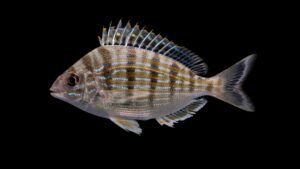
Lagodon rhomboides. Courtesy: ncfishes.com
The Pinfish Lagodon rhomboides, is a common member of the porgie or sea bream family Sparidae. It occurs in marine waters along the U.S. coast from Massachusetts to Texas, down along the Gulf Coast of Mexico, as well as Bermuda and some northern Caribbean islands. Linnaeus, the father of taxonomy, named it Sparus rhomboides in 1766, based on an illustration provided by Mark Catesby (1683-1749), one of the first naturalists to explore the New World. We believe the specific epithet rhomboides refers to the rhomboidal shape of the fish’s scales as illustrated by Catesby.
In 1855, American physician-naturalist John E. Holbrook (1796-1871) proposed Lagodon, a new genus for Sparus rhomboides. The name translates as lagos, Greek for hare or rabbit, and odon, Greek for tooth. We surmise that it refers to the eight broad, deeply notched incisor-like anterior teeth on both jaws.
If you’ve never read any of Wilson’s books, we highly recommend the following:
The Diversity of Life (1992)
Naturalist (1994)
Consilience: The Unity of Knowledge (1998)
The Future of Life (2001)
We regret not having read his Pulitzer Prize-winning magnum opus (written with Bert Hölldobler) The Ants. Unfortunately, the book has not been reprinted and used copies start at $141.37 on Amazon.
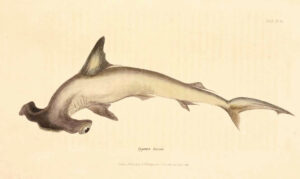
Zygaena (now Sphyrna) lewini. Illustrated by John William Lewin. From: Griffith, E. and C. H. Smith. 1834. The class Pisces, arranged by the Baron Cuvier, with supplementary additions. In: Cuvier, G: The animal kingdom, arranged in conformity with its organization. Vol. 10. Pisces. Whittaker & Co., London. 1-680, Pls. 1-62 + 3. [English treatment of Cuvier’s “Régne Animal”; supplements by Griffith and Smith.]
Sphyrna lewini (Griffith & Smith 1834)
In 2012, shark taxonomist David A. Ebert published a review of Jose I. Castro’s 2011 book The Sharks of North America in the journal Copeia (2012, No. 4, 765–778). It’s one of the most scathing reviews we’ve seen of a major ichthyological tome from a well-regarded specialist published by a major university press (Oxford). Ebert wrote:
“A major problem with the book is that the author frequently inserts his own opinion as fact and these opinions are often at odds with the published literature. He provides no supporting evidence while dismissing, or not even citing, the research of many contemporary researchers.”
The same can be said of Castro’s explanation of the etymology of the trivial name of the Scalloped Hammerhead Shark Sphyrna lewini, described by Griffith & Smith as Zygaena lewini
in 1834. Castro says the shark was “presumably” named in honor of Ludwig Lewin Jacobson (1783–1843), a “brilliant Danish military surgeon and one of the foremost anatomists of his age, a time when the nascent comparative anatomy under Georges Cuvier was the main basis for the study of biology.” Castro mentions that Jacobson discovered “what is now known as the vomeronasal organ of Jacobson, an accessory organ of many tetrapods. Cuvier published a description of this organ in 1811.” (Note: the organ does not occur in sharks.)
Castro did not explain how Jacobson was associated with Griffith & Smith nor why he was honored. (Or why Griffith & Smith chose his middle name over his surname.) In fact, when you read the Wikipedia entry for Jacobson, it seems he has no connection with sharks or sea-life whatsoever. Demonstrating Ebert’s major complaint about the book, Castro did not present any supporting evidence for his claim. Probably because there is no supporting evidence for his claim. There is, however, substantial evidence pointing to someone else.
Griffith & Smith did not identify the Lewin of lewini. They provide only a brief one-sentence description in the main text of the work. The name itself, Zygaena lewini, appears only on the accompanying plate (shown here). But Griffith & Smith did provide a tantalizing clue. They named another species after Lewin, Esox lewini, now known as Dinolestes lewini, the Long-finned Pike, a barracuda-like schooling fish from the coastal waters of Australia. Griffith & Smith described the fish “from a drawing by Mr. Lewin, made in New Holland [Australia], of a species not hitherto noticed.”
We believe “Mr. Lewin” is John William Lewin (1770–1819), an English-born artist who moved to Australia and illustrated early volumes of Australian natural history. (Sphyrna lewini was described from Australia.) This is almost certainly the same artist who illustrated the plates in Griffith and Smith’s book. Two birds are named after Lewin, Lewin’s Rail Lewinia pectoralis and Lewin’s Honeyeater Meliphaga lewinii. And, we are confident, two fishes as well.
The generic name Sphyrna, by the way, coined by Rafinesque in 1810, is probably a misspelling of sphyra, Greek for hammer, referring to their hammer-shaped heads.
15 December
Wool cards and fishes
This week’s entry continues the theme of last week’s — how tools and technology common to the 18th and 19th centuries are evoked in the names of several fishes described in those times. This week we look another tool. Wool cards.
I confess to never having heard of a wool card until I encountered one in the name of a fish. I blame the fact that I grew up in a major American city in the latter half of the 20th century and not on a farm during what we called the “olden days.” For those of you like me, a wool card is any kind of device with bristles used for separating and straightening sheep’s wool so that it can be used to make yarn for knitting. The process is now largely mechanical, but in the “olden days” people would card wool using a hand comb, similar to the kind of comb pet owners now used to groom their pets. The word “card” is derived from the Latin carduus, meaning thistle or teasel, as dried vegetable teasels were first used to comb the wool. Bristles made of wire now do the job.
Based on how wool cards have been evoked several in the names of fishes, I surmise that they were a common, everyday device in earlier times — common enough for four ichthyologists to examine a fish and exclaim, “Dang, that fish reminds me of a wool card!” In fact, our friend Holger Funk tells us that the fish-card connection dates to at least the Renaissance. In his Aquatilium animalium historiae liber primus of 1558, Hippolito Salviani (1514-1572) compared the dainty teeth of the European Bass Dicentrarchus labrax to wool cards. (The technical term for this arrangement is now known as “cardiform.”)
In 1858, French-American ichthyologist Charles Girard (1822-1895) described a new genus of fishes from the Pacific Ocean of North America. He named it Zaniolepis, from xanion, wool card, and lepis, Greek for scale, referring to the imbricated, extremely roughly ctenoid scales of Z. latipinnis, or, to use Girard’s words, “Dermic productions comb-like.” In a follow-up paper published later in 1858, Girard described “prickles of the skin … in the shape of comb-like scales.” The family Zaniolepididae, with just two species, is colloquially called Combfishes.
Thirty years later, zoologist Léon Vaillant (1834-1914) of the Muséum national d’Histoire naturelle in Paris, described a new species of grenadier from the coast of Western Sahara. He named it Macrurus (now Coryphaenoides) zaniophorus, i.e., comb-bearer, using the same Greek noun that Girard chose for Zaniolepis. Larger specimens have short, stout spinules on their scales arranged in V-shaped rows, resembling the wire bristles of wool cards.
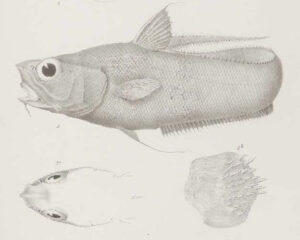
Coryphaenoides carminifer. ote the wool card-like spines on the scale. From: Garman, S. 1899. The Fishes. In: Reports on an exploration off the west coasts of Mexico, Central and South America, and off the Galapagos Islands … by the U. S. Fish Commission steamer “Albatross,” during 1891. No. XXVI. Memoirs of the Museum of Comparative Zoology v. 24: Text: 1-431, Atlas: Pls. 1-85 + A-N.
The noun xanion was used again by American ichthyologist Charles Henry Gilbert (1859-1928) when he described Catulus (now Parmaturus) xaniurus, a deepwater catshark from the eastern Pacific, in 1892. Oura is Greek for tail. The name refers to the crest-like row of tooth-like projections along the upper edge of its caudal fin.
For a southeastern Pacific congener of Coryphaenoides zaniophorus, Harvard ichthyologist-herpetologist Samuel Garman (1843-1927) chose the same name, except in Latin instead of Greek — carminifer (carmen, wool card + fero, to bear) — described in 1899. The name refers to the longitudinal series of spines on each scale, which give the fish a “pilose grayish brown appearance.”
Do you think any contemporary ichthyologists will name a fish after a tool that’s common today? A smartphone, perhaps? A drone? Photovoltaic cells?
8 December
Saddles, bridles and whips
Some fish names reflect the times in which they were described. In the 18th and 19th centuries, horses were the primary mode of transportation. Which may explain why horses are evoked so many times in the names of fishes described before the advent of “horseless carriages.”
Riding horses need saddles, of course. Ephippion is Greek for saddle. It Latin it’s sella. We count eight currently valid fish species from the 1700s and 1800s named for their saddle-like markings:
- Amphiprion ephippium (Bloch 1790), an anemonefish
- Chaetodon ephippium Cuvier 1831, a butterflyfish
- Thorogobius ephippiatus (Lowe 1839), a goby
- Stigmatogobius sella (Steindachner 1881), a mudskipper goby
- Apogon retrosella (Gill 1862), a cardinalfish (retro = back)
- Dascyllus albisella Gill 1862, a damselfish (albus = white)
- Microcottus sellaris (Gilbert 1896), a sculpin
- Argyripnus ephippiatus Gilbert & Cramer 1897, a bristlemouth
Riding horses also need bridles (frenum, Latin noun; frenatus, Latin adjective, i.e., bridled). These 18 fishes were all named for the bridle-like markings on the sides of their heads.
- Scarus frenatus Lacepède 1802, a parrotfish
- Sufflamen fraenatum (Latreille 1804), a triggerfish
- Scolopsis frenata (Cuvier 1830), a threadfin bream
- Pristiapogon fraenatus (Valenciennes 1832), a cardinalfish
- Sparisoma aurofrenatum (Valenciennes 1840), a parrotfish (auro = gold)
- Oxynoemacheilus frenatus (Heckel 1843), a stone loach
- Paramonacanthus frenatus (Peters 1855), a filefish
- Amphiprion frenatus Brevoort 1856, an anemonefish
- Crenicichla frenata Gill 1858, a pike cichlid
- Rypticus subbifrenatus Gill 1861, a soapfish (sub = somewhat; bi = two)
- Brachyistius frenatus Gill 1862, a surfperch
- Stegastes rectifraenum (Gill 1862), a damselfish (rectis = straight)
- Coryphopterus glaucofraenum Gill 1863, a goby (glaucus = hoary blue)
- Arenigobius bifrenatus (Kner 1865), a goby (bi = two)
- Notropis bifrenatus (Cope 1867), a shiner or minnow (bi = two)
- Gymnocranius frenatus Bleeker 1873, a large-eye seabream
- Zaniolepis frenata Eigenmann & Eigenmann 1889, a combfish
- Sarritor frenatus (Gilbert 1896), a cardinalfish
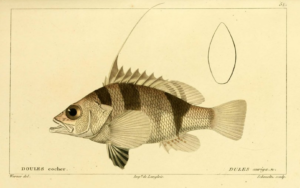
Dules auriga, named for the long, whip-like third spine of its dorsal fin. From: Cuvier, G. and A. Valenciennes. 1829. Histoire naturelle des poissons. Tome troisième. Suite du Livre troisième. Des percoïdes à dorsale unique à sept rayons branchiaux et à dents en velours ou en cardes. F. G. Levrault, Paris. v. 3: i-xxviii + 2 pp. + 1-500, Pls. 41-71.
We can imagine that some 18th- and 19th-century zoologists, at least those who could afford it, commuted between museum and home via a horse-drawn carriage. That may explain these five fishes, all of which have filamentous or whip-like fins, were named auriga, the Latin word for driver or charioteer, i.e., a coachman or carriage driver, who drives and “encourages” his horse with the help of a whip.
- Chaetodon auriga Forsskål 1775, a butterflyfish
- Dules auriga Cuvier 1829, a sea bass or grouper
- Pagrus auriga Valenciennes 1843, a porgie or seabream
- Pteragogus aurigarius (Richardson 1845), a wrasse
- Trichiurus auriga Klunzinger 1884, a cutlassfish
Interestingly, we haven’t found any modern-day fish names that evoke fenders, grills and steering wheels. What do you make of that?
1 December
Universal Human Rights Month
Today, December 1, is the beginning of Universal Human Rights Month, a time for people around the world to join together and stand up for the rights and dignity of all individuals.
Human rights are evoked in the names of three fishes:
Dicrossus foirni Römer, Hahn & Vergara 2010 — This cichlid occurs in the Rio Negro drainage of Brazil. It is named in honor of FOIRN, Federação das Organizações Indígenas do Rio Negro, a non-governmental organization that has repeatedly given scientists permission to travel on the tribal land of the village communities of different indigenous groups in the middle and upper Rio Negro and its affluent rivers, permitting the observation and collection of this species and D. warzeli (described at the same time). According to the authors, the “name is also intended to highlight the fact that the basic human rights of indigenous peoples, who depend on large functional ecosystems for all necessary resources, are still in question in most parts of Amazonia when business projects (such as logging, mining, or the building of hydroelectric dams) are planned in the wilderness of the Neotropical rainforests.” FOIRN was founded to help indigenous peoples along the Rio Negro take over responsibilities and decision-making powers for their land and resources from local governmental organizations.
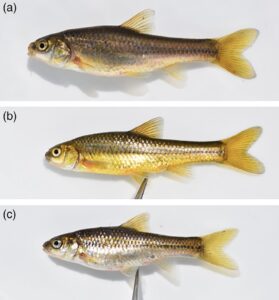
Lateral view of live Enteromius mandelai, showing live coloration of mature breeding (a) female, (b) male, and (c) female specimens. From: Kambikambi, M. J., W. T. Kadye and A. Chakona. 2021. Allopatric differentiation in the Enteromius anoplus complex in South Africa, with the revalidation of E. cernuus and E. oraniensis, and description of a new species, E. mandelai (Teleostei: Cyprinidae). Journal of Fish Biology v. 99 (no. 3): 931-954.
Etheostoma jimmycarter Layman & Mayden 2012 — This darter (Percidae), the Bluegrass Darter, is endemic to the Green River drainage of Kentucky and Tennessee. It is named in honor of Jimmy Carter (b. 1924), the 39th President of the United States of America, for his “environmental leadership and accomplishments in the areas of national energy policy and wilderness protection, and his life-long commitment to social justice and basic human rights.” (The name is a noun in apposition, without the patronymic “i.”)
Enteromius mandelai Kambikambi, Kadye & Chakona 2021 — The name of this recently described barb (Cyprinidae), the Eastern Cape Chubbyhead, honors Nelson Mandela (1918-2013), South Africa’s first democratically elected head of state, who was from the Eastern Cape Province where this species is endemic. The authors praise Mandela for his “legacy and selfless contribution towards promotion of peace, democracy, human rights, equality, social justice and sustainable development.”
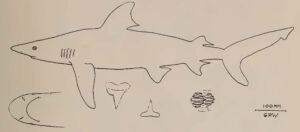
Carcharhinus cautus. From: Whitley, G. P. 1945. New sharks and fishes from Western Australia. Part 2. Australian Zoologist v. 11 (pt 1): 1-42, Pl. 1.
24 November
The Nervous Shark, Carcharhinus cautus
For most people, “nervous” is not an adjective they would normally associate with sharks. Aggressive, yes. Mean. Scary. Dangerous. Adjectives like that. But nervous? No, not really. Yet that’s the adjective ichthyologist Gilbert Whitley used when he described Carcharhinus cautus, an Indo-Pacific shark, in 1945.
Actually, Whitley did not explicitly explain the name in his 1945 description. But he mentioned that Carcharhinus cautus is the same shark he called the “Nervous Shark” in his 1940 book The fishes of Australia. Part I. The sharks, rays, devil-fish, and other primitive fishes of Australia and New Zealand. We googled the title and were able to secure a second-hand copy at a reasonable price. Whitley wrote:
When at Shark’s Bay, Western Australia, I sometimes saw small black Galeoid sharks in shallow water but never could approach them closely since the slightest splashing caused them to dash away at great speed into deep water. Some teeth, perhaps of this species, were given to me by Mr. C. Fletcher of Willamia, Unless Inlet, and agree with no other Australian species.
Whitley eventually captured one of these Nervous Sharks, from Herald Bight, Shark Bay, in Western Australia. “Many specimens were swimming about at the time,” he wrote, “but though my companions and I tried to wade near them, we were unable to get close and only managed to net one of the school.” It was an immature female, about a meter long and 5 kg in weight.
Whitley described the shark as a subspecies of Galeolamna greyi (now a junior synonym of the Dusky Shark Carcharhinus obscurus). The subspecies has since been recognized as a full species and moved to the genus Carcharhinus.
“Cautus” is Latin for nervous, cautious or wary.
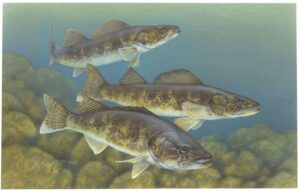
Walleye (Sander vitreus) from the U.S. Fish and Wildlife Service.
17 November
Stizostedion vs. Sander
When I read John C. Bruner’s essay In the June 2021 issue of Fisheries magazine, I knew something was not quite right. Bruner argued that Stizostedion Rafinesque 1820 should replace Sander Oken 1817 as the proper generic name for Walleye, Sauger and European pikeperches. If Bruner was correct, then his argument would apply and perhaps necessitate the changing of 14 other currently valid generic names dating to Oken 1817. I sent Bruner’s essay to ichthyologist Ronald Fricke, one of the editors of Eschmeyer’s Catalog of Fishes, and he agreed something was amiss. As we reexamined Bruner’s evidence, Dr. Fricke and I concluded that Sander should be retained. We collaborated on a rebuttal essay, which Fisheries magazine recently published online (and will likely appear in print early next year).
The Stizostedion vs. Sander debate has been around since 1903. Rafinesque proposed Stizostedion (stizo, prick; stithios, a little breast, referring to “pungent throat” or spiny opercle at pectoral-fin base of S. vitreus) in 1820. In 1903, Theodore Gill revealed that Sander Oken 1817 (based on Cuvier’s “Les Sandres,” from zander, German name for S. lucioperca) predates Stizostedion and should replace it. Gill’s paper was largely ignored until European and Russian ichthyologists started using Sander in the 1990s. This prompted the Committee on Names of Fishes, a joint committee of the American Fisheries Society and American Society of Ichthyologists and Herpetologists, to examine the issue. In 2003, they recommended that Sander replace Stizostedion. This change, a significant one considering the commercial importance of Walleye and Sauger, has been adopted by nearly every academic and popular publication ever since.
Bruner rejected Sander in favor of Stizostedion on the grounds that Gill incorrectly treated Oken’s Sander as a properly erected generic name. According to Bruner, Oken did not latinize “Sander” (e.g., Sandrus) nor differentiate the genus and designate a type species, all required actions, Bruner implied, for making a genus-level name available. We counter-argued that Sander is an acceptably formed and published scientific name consistent with standards predating the International Commission of Zoological Nomenclature (ICZN). Indeed, our main concern with Bruner’s arguments is that they apply modern-day nomenclatural guidelines to a taxon proposed in the early days of binominal zoological nomenclature, decades before the publication of the first edition of the ICZN code in 1905. Simply put, Oken’s Sander, while it would not pass nomenclatural muster today, is “grandfathered” in. So too are 14 other currently valid names proposed by Oken: Atropus, Brosme, Cirrhinus, Diagramma, Lota, Piabucus, Plectropomus, Polyprion, Priacanthus, Pterois, Raniceps, Schilbe, Stellifer, and Triacanthus. Should we throw them out as well?
I could spell out our arguments in more detail, but then there would be no need to read the essay, which is available here. (If you can’t get past the paywall, click on my email and I’ll send you a copy.) Bruner’s essay is freely available here.
You be the judge!
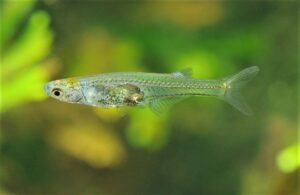
An adult male Danionella cerebrum, ca. 10 mm SL. From: Britz, R., K. W. Conway and L. Rüber. 2021. The emerging vertebrate model species for neurophysiological studies is Danionella cerebrum, new species (Teleostei: Cyprinidae). Scientific Reports v. 11: 18942: 1-11.
10 November
Danionella cerebrum Britz, Conway & Rüber 2021
A handful of fishes are named for their importance to humans. Among them are the American Shad, Alosa sapidissima, whose name means “most delicious,” and the tilapiine cichlid Oreochromis esculentus, meaning edible, referring to its former importance for human sustenance along Africa’s Lake Victoria (the species is now critically endangered). To this rather small list of fish names we can add an extremely small new species, Danionella cerebrum, named for its value not on the dinner plate but in the lab.
Maturing at just 10–15 mm in length, the genus Danionella from Myanmar and northeastern India are among the smallest vertebrates in the world. The fifth and most recently described species has “brainy” name — cerebrum.
Danionella cerebrum is known from a number of streams on the southern and eastern slopes of the Bago Yoma mountain range of Myanmar. Its name, Latin for brain, refers to the fact that it has one of the smallest adult brains among vertebrates, thereby making it a promising new model species for neurophysiological studies. One of the striking morphological features of the larval-like Danionella is that the roof of their skull is missing. Instead, it’s covered by skin, which allows researchers to study neurophysiological questions by deep imaging the fish’s brain activity while the fish is still alive.
Having a tiny, larval-like brain, the authors write, makes Danionella cerebrum a “promising new model species” for neuroscientists interested in learning more about brain activity and function.
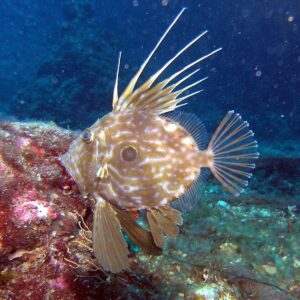
Zeus faber. Courtesy: Wikipedia.
3 November
Zeus faber Linnaeus 1758
Names that date to antiquity are often hard to figure out. These names appear in classical texts with little or no context, their original meanings vague or unknown. Over the centuries, an ancient name may be applied to several different species, further complicating its history. Its spelling may be changed as it’s translated between Latin and Greek and eventually into German, French or English. By the time the likes of Artedi and Linnaeus affix the name to the fish by which it is known today, its original meaning, spelling and application may be long gone. And when more contemporary scholars make unsubstantiated claims about its provenance, the etymological waters are muddied even more. Both parts of the name of the John Dory — the generic name Zeus and the specific name faber — have deep, tangled histories that we are just beginning to decipher.
Let’s start with the specific epithet faber, which is the easier of the two names to pin down. We know that “faber” is the Latin word for craftsman, carpenter or workman, but we had no idea how that word could apply to this fish. So, we published all that we knew: Faber is “ancient name for this species, dating to at least ‘Halieutica’ (‘On Fishing’), a fragmentary didactic poem spuriously attributed to Ovid, circa AD 17.”
Then we met Holger Funk, a scholar of Greek and Latin who is researching the emergence of modern ichthyology in the 16th century. He has traced “faber” to a 1533 work by French naturalist, topographer and translator Pierre Gilles (aka Petrus Gyllius), De gallicis et latinis nominibus piscium (The French and Latin names of fishes). Gilles said people from Dalmatia (a region on the eastern shore of the Adriatic Sea, now part of Croatia) called the fish “faber,” meaning craftsman, referring to how “all the tools can be found in it” (translation). Hippolito Salviani, in his Aquatilium Animalium Historiae (1558), repeated and embellished Gilles’ claim, adding that the fish’s dorsal-, ventral- and anal-fin spines, and its head bones, resemble the tools of a craftsman. Whether this name traces back to “Halieutica” is impossible to say. But at least we have a viable explanation as to why ancient scholars and writers applied the noun “faber” to this fish.
The meaning of Zeus is a tougher and perhaps impossible knot to untie. This is what we had posted: “the Greek god Zeus, equivalent to the Roman god Jove or Jupiter, referring to the ancient name of Z. faber, ‘Piscis Jovii.’”
The source of this explanation is a 1902 article by David Starr Jordan, the dean of American ichthyology (“The History of Ichthyology,” Science, v. 16 [no. 398]: 241-258). Jordan’s explanation has been repeated in many references, including ETYFish. According to Dr. Funk, it’s total rubbish. Jordan provided no evidence for claim, and Funk has never seen “Piscis Jovii” mentioned in any classical lexicon. A Google search supports this notion. The #2 hit is Jordan’s article.
So, if Jordan’s “Piscis Jovii” is rubbish, then where did the name “Zeus” come from? It’s true, zeus, like faber, was an ancient name for the John Dory. Pliny mentions this in his Natural History (Book IX, Chap. 32). But Pliny spelled the name as Zaeus (from the Greek Ζαιός),
According to Dr. Funk, zaeus and zeus are not necessarily the same word. Nowadays, “zaeus” is speculatively associated with ζαιός (stormy, windy), which doesn’t seem to apply to this fish. What’s more, there is no record that the Greeks and Romans used the “zeus” spelling. In fact, in classical Latin, Zeus, the god, is almost always referred to as Iupiter or Iuppiter. The “zeus” spelling for the fish was adopted by Renaissance naturalists and then codified by Artedi and Linnaeus, who, in Funk’s words, “made the nonsense official.” The “Zeus” of Zeus faber may have nothing to do with the chief Greek deity. It may simply have been a Greek word for the fish whose meaning, if any, has been lost to time.
Our thanks to Holger Funk for sharing his research and philological expertise.
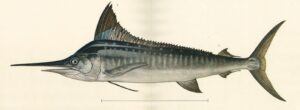
Kajikia mitsukurii (=audax). From: Hirasaka, K. and H. Nakamura. 1947. On the Formosan spear-fishes. Bulletin of the Oceanographic Institute Taiwan No. 3: 9-24, Pls. 1-3.
27 October
Kajikia Hirasaka & Nakamura 1947 is now Kajikia Marshall & Palmer 1950
Article 13.3 of the International Code of Zoological Nomenclature strikes again! This time the subject is not some obscure group of fishes known only to ichthyologists. It’s the genus Kajikia, which contains two of the most prized sportfishes in the world, the White Marlin K. albida, and the Striped Marlin, K. audax.
According to Article 13.3, every new genus-group name published after 1930 must be accompanied by the fixation of a type species in the original publication (or be expressly proposed as a new replacement name) in order to be available. If not, then the genus is not considered validly described until someone indicates a type – sometimes when the genus is mentioned in the Zoological Record (ZR), the unofficial registry of scientific names in zoology. In these cases, the author(s) of the ZR entry are not intending to designate the type. Usually, they’re just assuming the first-mentioned species is the type and record it as such. But in so doing, they inadvertently became the “author” of the name even though they had nothing to do with studying the genus, examining the specimens, and proposing the name in question.
This is precisely what happened with Kajikia, proposed by Japanese ichthyologists Kysoke Hirasaka and Hiroshi Nakamura in their 1947 paper “On the Formosan Spear-Fishes.” They included two species in the genus, K. formosana and K. mitsukurii, both now considered junior synonyms of K. audax (Philippi 1887). Unfortunately, they did not indicate which of the two species should be the representative “type” of the genus. Three years later, when the Zoological Record for 1947 was published, K. formosana was indicated as the type. The authors of the fish section, Marshall & Palmer, thus inadvertently became the authors of the genus.
Art. 13.3 is a quirky rule, but the fixation of types is an important concept in taxonomy. Every genus should have a single species that provides the objective standard of reference by which that genus is differentiated from closely related genera. Since Hirasaka & Nakamura did not mention which of their two species of Kajikia provided that objective standard, authorship of the genus is credited to those who did. Our guess is that Hirasaka & Nakamura simply did not know about Art. 13.3. It may have been added when the Code was amended in 1930, the news of which probably did not make its way to post-war Japan.
In the course of our etymological research, we’ve found two instances in which Art. 13.3 needed to be applied: the sculpin genera Artediellichthys (NOTW 23 June 2021) and Leocottus (NOTW 15 Sept. 2021). We also found one instance in which Art. 13.3 was erroneously applied: the barrucudina genus Macroparalepis (NOTW 18 May 2016).
What does kajikia mean? It’s derived from kajiki, the Japanese word for marlin or sailfish.
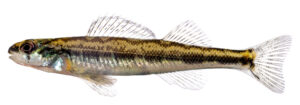
Percina nevisensis. Courtesy: ncfishes.com
20 October
Percina nevisensis (not nevisense)
The Chainback Darter (Percidae) occurs in gravel runs and riffles of small to medium-sized rivers from the Roanoke-Chowan River drainage of Virginia south to the Neuse River drainage of North Carolina in the eastern United States. Nearly every contemporary reference gives its scientific name as Percina nevisense. When we took a closer look at the etymology of “nevisense,” however, we discovered that it should be spelled “nevisensis.” Here’s why:
Edward Drinker Cope described this species as Etheostoma nevisense in 1870. As was his custom, he did not explain the meaning of its name. Near the beginning of the 20th century, American ichthyologists began treating the species as a junior synonym of the Shield Darter, Percina peltata. In the 1980s, “darterologists” considered it a subspecies of P. peltata. In 1998, the taxon returned to full species status. During all these taxonomic maneuverings, no one bothered to look at the spelling of its name, perhaps because a major reference explained what it meant. In the 1983 book American Darters, authors Kuehne and Barber stated that “nevisense” means “birthmark,” probably referring to its blotches, which Cope described as “dark chestnut quadrate spots” on sides.
According to our dictionaries, “naevus” is the Latin noun for birthmark. We’re not sure how Keuhne and Barber saw “naevus” in “nevisense.”
We’re also not sure how Kuehne and Barber missed a more obvious, and therefore more likely, explanation of the name.
Animals named after places often have the adjectival suffix “-ensis” in their specific names. For masculine and feminine genera, “-ensis” is the correct spelling. For neuter names, the correct spelling is “-ense.” Note that Cope originally described the darter in the genus Etheostoma. The gender of Etheostoma is neuter. So, if Cope named the darter after a place, “nevisense” — not “nevisensis” — would have been the proper spelling based on its placement in Etheostoma.
But what place was Cope referring to? We’re not 100% sure but we have a very good guess. Cope described the species from one specimen from the Neuse River in Wake County, North Carolina. Since Cope was classically trained (as were most scientists of the time), he probably latinized the “u” of Neuse to “v” (in Classical Latin the “v” shape was used for both the vowel “u” and the consonant “v”). The addition of the “i” is harder to explain. Cope may have added it for euphony (“nevisense” is slightly better-sounding than “nevsense”). Or perhaps it is a typographical error. In those pre-digital (and pre-typewriter) days, handwritten manuscripts were often rife with errors, and hand-set galleys were not usually sent to reviewers and proofreaders before publication as they are today.
Long story short: “From the Neuse River” is a more likely explanation than “birthmark.” Since Percina is a feminine genus — and if you accept the notion that the specific epithet is an adjective, not a noun — then the spelling of “nevisense” should be emended to “nevisensis.”
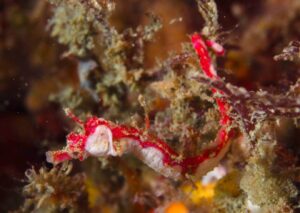
Cylix tupareomanaia at Waiatapaua Bay, Whangaruru, Northland, New Zealand, 12 m depth. © Irene Middleton, from an Auckland Museum press release. Also appeared in: Short, G. A. and T. Trnski. 2021. A new genus and species of Pygmy Pipehorse from Taitokerau Northland, Aotearoa New Zealand, with a redescription of Acentronura Kaup, 1853 and Idiotropiscis Whitley, 1947 (Teleostei, Syngnathidae). Ichthyology & Herpetology 109 (3): 806-835.
13 October
Cylix tupareomanaia Short, Trnski & Ngātiwai 2021
As far as we know, this is the first animal in the world to have its naming authority, or authorship, include not just the name of a person but that of an entire tribe.
Cylix tupareomanaia is both a new genus and species of pygmy pipehorse — 6 cm long — from rocky reefs off the northeast coast of New Zealand. It was discovered by divers in 2011, who initially identified it as a Collared Seahorse, Hippocampus jugumus. When photos circulated on the Internet in 2017, ichthyologist Graham A. Short (California Academy of Sciences) recognized it as a potentially new species. Thomas Trnski (Tāmaki Paenga Hira Auckland Museum) joined Short to hand-collect specimens and prepare a formal description.
Short and Trnski are credited as the authors of the generic name Cylix. It’s derived from the Greek kylix, meaning cup or chalice, referring to the cup-like pentamerous crest on top of the pipehorse’s head. For the specific epithet, Short and Trnski conferred with kaumātua (tribal elders) of Ngātiwai (a local Māori iwi, or tribe), to incorporate mātauranga (Māori knowledge) into the naming process. The kaumatua “gifted” (the verb used in the description’s etymology section) the name tupareomanaia, a neologism comprised of two indigenous names:
tupareo — from Tu Pare o Huia, “plume of the huia,” Ngātiwai name for Home Point, adjacent to the type locality, itself a combination of pare, plume or garland, and huia, an extinct bird, referring to the pipehorse’s head crest
Manaia — Māori name for a seahorse (also an ancestor that appears as a stylized figure used in Māori carvings representing a guardian)
The name of the Ngātiwai tribe — not a single person in the tribe but the entire tribe itself — is credited with co-authorship of the name: Short, Trnski & Ngātiwai 2021.
Ngātiwai kaumātua Hori Parata said, “The naming of this taonga [treasure] is significant to Ngātiwai as we know there are stories from our tupuna [ancestors] about this species, but the original name has been lost as a result of the negative impacts of colonisation.”
Ngātiwai are kaitiaki (guardians) of the biodiversity within their rohe (territory), and they regard the marine species as nationally significant taonga (treasures).
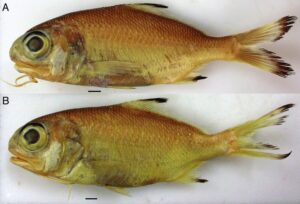
Type specimens of Polymixia hollisterae. From: Grande, T. C. and M. V. H. Wilson 2021. A new cryptic species of Polymixia (Teleostei, Acanthomorpha, Polymixiiformes, Polymixiidae) revealed by molecules and morphology. Ichthyology & Herpetology 109 (2): 567-586.
6 October
Polymixia hollisterae Grande & Wilson 2021
The person for whom this species is named was such a trailblazer, the authors appended their description with a short biographical essay, which we summarize below.
The Bermuda Beardfish Polymixia hollisterae is a new species known from only three specimens, two collected along the northwest edge of the Bermuda Platform in the western Atlantic, and one (a juvenile) collected in the Gulf of Mexico. Its specific name honor Gloria E. Hollister (married name Anable), B.S., M.S. (1900–1988). In the etymology section, the authors describe her as a “pioneering ichthyologist, key member of the William Beebe bathysphere expeditions in Bermuda, world record holder for deep-sea descent by a woman, leader of tropical zoological expedition, Red Cross Blood Bank pioneer, and ground breaking conservationist.” The authors then direct us to Appendix 1 for more about her accomplishments.
Gloria Hollister graduated with a degree in zoology from Connecticut College (B.S. 1924) and a master’s from Columbia University (M.S. 1925). During this time, she participated in an expedition to British Guiana, where, records suggest, she met William Beebe (1877–1962) for the first time. Beebe, a naturalist and explorer working for the New York Zoological Society (now the Wildlife Conservation Society), would soon be famous for his deep-sea dives aboard the Bathysphere, a spherical deep-sea submersible, and his best-selling account of these dives, Half-Mile Down. His dives marked the first time that a marine biologist observed deep-sea animals in their native environment.
Hollister was a key member of Beebe’s team during his deep-sea Bathysphere explorations in the waters off Bermuda from 1928 to 1940. Her main responsibilities were surface-to- Bathysphere communication and the recording of the conversations to and from the submersible, and identifying the fishes Beebe saw. She also descended in the Bathysphere herself, setting records for depth of descent by a woman — 410 feet (125 m) in 1930 and 1,208 feet (368 m) in 1934 — the latter a record that stood for decades.

Gloria Hollister and her “Fish Magic.”
Working in the team’s laboratory on Nonsuch Island in Bermuda, Hollister perfected and published the first reliable method of clearing and staining fishes for study of their osteology. She called the results ‘‘Fish Magic.’’
In 1941, Hollister joined the American Red Cross to help organize its first blood donor project; the blood was badly needed because of World War II. She eventually became the public face of the Red Cross and blood donation. At around this time she married Anthony Anable, a chemical and metallurgical engineer.
After the end of the war, Hollister led a citizens’ effort to save from imminent destruction the Mianus River Gorge near the New York-Connecticut border. Working with The Nature Conservancy, Hollister and other like-minded conservationists, they purchased the Gorge, which became the first ever land purchase project of The Nature Conservancy, and later became the first National Natural Landmark to be officially registered in the U.S.
According to Wikipedia, Hollister spent the last three years of her life at a convalescent hospital in Fairfield, Connecticut. She died of cardiac arrest on February 19, 1988, at the age of 87.
The etymology of the generic name Polymixia is also worth noting. Proposed by British biologist-clergyman Richard Thomas Lowe (1802-1874) in 1836, the name is a combination of poly, many, and myxia, mixing, referring to how the type species, P. nobilis, appears to combine characters from multiple groups of fishes (e.g., the general aspect of Berycidae, the chin barbels of Mullidae). The name has proven to be prophetic. The genus, now with 11 species, has defied easy placement in fish classifications, jumping from one order to the next depending on the study. It currently sits in its own order, Polymixiiformes, phylogenetically positioned at or near the base of the Paracanthopterygii, a group that also includes the orders Percopsiformes, Zeiformes, Stylephoriformes, and Gadiformes.
According to one ichthyologist, “If there is an acanthomorph equivalent of the living monotremes [platypus and echidnas] amongst mammals, it is Polymixia …”

John “Jack” Musick, from his obituary at Legacy.com.
29 September
Stellifer musicki Chao, Carvalho-Filho & Andrade Santos 2021
John Andrew Musick, known to all as Jack, passed away at home in Gloucester, Virginia, on February 13, 2021, at the age of 80. He was the Marshall Acuff Professor of Marine Science Emeritus at the Virginia Institute of Marine Science, College of William and Mary, where he taught ichthyology, conservation biology, deep sea biology, biological oceanography, and marine fisheries science from 1968 until his retirement in 2009.
Jack was senior author or coauthor of 170 scientific papers, served as coauthor and editor of 14 scientific books and proceedings, and coauthored eight trade books, four of them with his wife Beverly, a science writer. Their book The Shark Chronicles detailed Jack’s life and times studying sharks with other prominent researchers. He also co-authored Fishes of the Chesapeake Bay (Smithsonian Institution Press, 1997).
Born in Trenton, New Jersey, Jack spent his boyhood collecting snakes and other critters both large and small. After his father’s death when Jack was only 12, his mother marshalled uncles and friends to help nurture Jack’s blossoming interest in fishes, particularly the marine species that he could catch along the Jersey shore. An undergraduate degree from Rutgers University and a masters and Ph.D. from Harvard University led to a life of bliss — studying the marine creatures he loved so much, and mentoring students. All told Jack served as a Major Advisor to 38 master’s and 50 Ph.D. students.
Jack’s fascination with sharks drove much of his research. He was a founding member and early president of the American Elasmobranch Society. An ardent advocate for shark conservation, Jack was instrumental in convincing Congress to pass legislation regulating commercial shark fisheries along the eastern seaboard while supporting recreational fisheries. In the early 1970s he established what became the world’s longest time series of annual shark surveys, a tool that to this day continues to help with global shark management. This and other research led to Jack serving many years as co-chair of the Shark Specialist Group of the International Union for the Conservation of Nature (IUCN).
In addition to sharks, Jack was an expert on sea turtles. He cofounded and served as president of the International Sea Turtle Society (ISTS) and helped pioneer the use of satellite tracking to better understand the biology and life history of leatherback and loggerhead sea turtles. For more than 25 years he served as Regional Coordinator for Virginia for the National Marine Fisheries Service Sea Turtle Stranding Network.
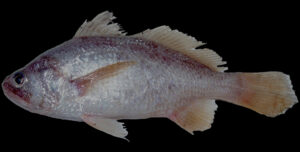
Stellifer musicki. From: Chao, N. L., A. Carvalho-Filho and J. de Andrade Santos. 2021. Five new species of Western Atlantic stardrums, Stellifer (Perciformes: Sciaenidae) with a key to Atlantic Stellifer species. Zootaxa 4991 (no. 3): 434-466.
When Jack passed away in February, we did not honor him in a “Name of the Week” because we could not link him to the name of a fish. He never named a new species, and no currently valid fish species is named after him. (Urophycis musicki Cohen & Lavenberg 1984, a phycid hake, is now treated as a junior synonym of Phycis blennoides.) But a recent paper in the journal Zootaxa has remedied this situation. In a June 2021 review of Western Atlantic stardrums of the genus Stellifer (Sciaenidae), a fish now bears Jack’s name:
Stellifer musicki is endemic to Brazil, south of Amazon River delta from Bragança, Pará, to Bahia. It can be distinguished from all other Atlantic species of the genus with a horizontal or inferior mouth by its large, oblique mouth and large eye (3.8–4.5 in HL). The etymology section reads: “This species is named in honor of the late Dr. Jack A. Musick, formerly at the Virginia Institute of Marine Science, College of William and Mary. Jack was the major professor of N.L. Chao [senior author of description] and many students, including several Brazilian ichthyologists.”
22 September
Four autumnal fishes
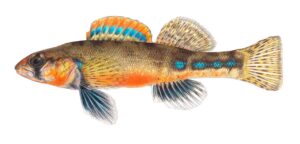
Autumn Darter, Etheostoma autumnale. © Joseph R. Tomelleri.
Today is the first day of autumn in the temperate Northern Hemisphere. In Latin, autumnus means a “season of increase and abundance,” referring to the ripening and harvest of fruits, vegetables and grains that grew over the summer. Four fishes have been named for autumn, two for their seasonal behavior and two for their colors, reminiscent of the leaves of deciduous trees as they prepare to shed.
Alosa braschnikowi autumnalis (Berg 1915) This subspecies of the Caspian Marine Shad is named for the fact that it is the only clupeid (or herring) that occurs in the southern Caspian Sea during September and October.
Coregonus autumnalis (Pallas 1776) The Arctic Cisco of Siberia, Alaska and Canada is named for how it migrates from the sea to fresh water in “immense numbers” (translation) during the autumn months of the year.
Badis autumnum Valdesalici & van der Voort 2015 Members of the family Badidae are called chameleonfishes for their ability to change colors to match their surroundings and suit their moods. Badis autumnum from West Bengal, India, is named for the numerous colors of autumn (combinations of brown, black, yellow and orange) it can display at any given time. We find it interesting that most of India does not experience the colorful seasonal makeover for which the fish is named. We suspect the authors — from Italy and Switzerland, respectively — are reflecting their geographic bias.
Etheostoma autumnale Mayden 2010 The Autumn Darter (Percidae) is named for its reddish-orange, orange, brown, tan, and reddish-yellow colors, typical of the seasonal autumn colors found in the Ozarkian hardwood forests of Missouri and Arkansas (USA), where it is endemic. The name also honors Frank B. Cross (1925–2001), Curator of Fishes, University of Kansas, a “great ichthyologist, naturalist, mentor, and friend” who was “adamant” that this darter not be named after him. So Mayden named it for “one of [Cross’] favorite seasons of the year.”

Dmitrii Nikolaevich Taliev at work in October 1946. Photo by D. G. Debabov. From: Taliev, D. N. 1955. Sculpin fishes of Lake Baikal (Cottoidei). Izdatel’stvo Akademii Nauk S.S.S.R., Moscow and Leningrad. 1-603, 2 foldout tables.
15 September
Leocottus Taliev 1955 is now Leocottus Palmer 1961
According to ICZN Art. 13.3, every new genus-group name published after 1930 must be accompanied by the fixation of a type species in the original publication (or be expressly proposed as a new replacement name) in order for that name to be available.
Dmitrii Nikolaevich Taliev (1908-1952) was a Soviet ichthyologist-limnologist known for his work studying the sculpins of Russia’s Lake Baikal. Three years after his death, his magnum opus, the 600+ page Sculpin Fishes of Lake Baikal (Cottoidei), was published. In it he proposed Leocottus, a subgenus of Paracottus with two included species and one subspecies. Unfortunately, he did not designate which species represents the type — i.e., the standard bearer or prototypical representative — of the subgenus (which Russian ichthyologists began treating as a full genus in 2001). Based on contextual clues, it appears that Taliev intended Paracottus (Leocottus) pelagicus, now a junior synonym of L. kesslerii (Dybowski 1874), to be the type. But since he did not explicitly say so, the authorship of the name — i.e., who first made it available and when — has remained in limbo for decades. Until we took a closer look.
While researching the etymology of the name (more on that below), we also researched its publication history looking for its first available use. Not surprisingly, we found it in the Zoological Record for 1958 (published in 1961),* in which Paracottus (Leocottus) pelagicus is designated as the type. The author of Leocottus, unintentionally, is G. Palmer, British Museum (Natural History), a compiler for the Zoological Record.
As for the etymology of Leocottus, Taliev was equally non-committal. Cottus, of course, is the type genus of the sculpin family Cottidae. But what does “leo” mean? Lion, maybe? But there is nothing lion-like about L. pelagicus as far as we can tell (it doesn’t have mane). Perhaps “Leo” is short for “leios,” meaning smooth. But there is already a sculpin genus Leiocottus Girard 1856 from the Pacific coast of North America, named for its “perfectly smooth” skin. And there is nothing in Taliev’s description of the species and subgenus that stands out as being “smooth.”
Our best guess is that “Leo” refers to Russian ichthyologist Lev (or Leo) Semyonovich Berg (1876-1950). Berg wrote several papers on Lake Baikal sculpins that Taliev cited in his monograph, and described over a dozen sculpin taxa himself. If we are correct, then Leocottus means “Leo’s sculpin.”
* Our thanks to Johannes Müller, who skillfully navigated Covid-19 restrictions at the Naturalis Library (Leiden, Netherlands) to scan the 1958 Zoological Record for us.
8 September
Humble-bragging
Humble-bragging is defined as “the action of making an ostensibly modest or self-deprecating statement with the actual intention of drawing attention to something of which one is proud.”
Recently, we’ve been gratified to see our humble ETYFish Project cited in two peer-reviewed publications. It was especially gratifying to see our first-ever citation in Ichthyology & Herpetology (formerly Copeia), the quarterly publication of the American Society of Ichthyologists and Herpetologists and one of the most respected ichthyological journals in the world.
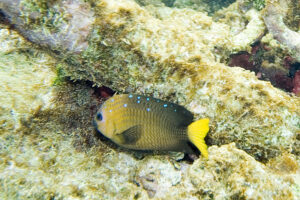
Yellowtail Damselfish, Microspathodon chrysurus, adult. Courtesy: Wikipedia.
The citation appeared in a major new study, “Systematics of Damselfishes,” by Kevin L. Tang, Melanie L. J. Stiassny, Richard L. Mayden, and Robert DeSalle (Ichthyology & Herpetology 109, No. 1, 2021, 258-318). The authors proposed a number of generic reassignments and other taxonomic changes, all of which have been incorporated into our etymological coverage of the family. The ETYFish Project is cited in the section discussing the genus Microspathodon. The authors write:
This genus is composed of four species from the Atlantic and eastern Pacific, three of which are found in rocky habitats, with the fourth (Microspathodon chrysurus) inhabiting coral reefs. The name likely derives from their distinctive dentition (Jordan and Evermann, 1898: 1565; Scharpf and Lazara, 2020).
While we love being cited alongside David Starr Jordan, Barton Warton Evermann, and their legendary four-volume Fishes of North and Middle America (1896-1900), we wish the authors had included more of our etymological explanation, which involved an extra bit of research —the actual examination of a preserved Microspathodon specimen in Australia. You can read the full story at our 29 August 2018 “Name of the Week.”
The second recent citation calls us out for two oversights. The paper is “Historical review on the type locality of Knodus victoriae (Steindachner 1907) (Teleostei: Characidae) and Loricaria parnahybae Steindachner 1907 (Teleostei: Loricariidae),” by Rayane Gonçalves Aguiar, Erick Cristofore Guimarães, Luis Fernando Carvalho-Costa, and Felipe Polivanov Ottoni (Biota Neotropica 21, No. 4, art. 20211226: 1-4).
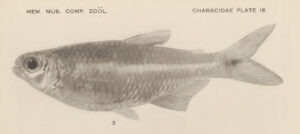
Knodus victoriae. From: Eigenmann, C. H. 1918. The American Characidae. Part 2. Memoirs of the Museum of Comparative Zoology v. 43 (pt 2): 103-208, Pls. 3, 8-11, 13, 16-29, 33, 78-80, 93, 101.
Our entries for Knodus victoriae and Loricaria parnahybae stated that the type localities for both species is Victoria, a town near the mouth of the Parnaíba River in Brazil, as reported in Steindachner’s original descriptions. But, as the authors point out, Victoria is actually located in the upper Parnaiba River basin, not in its lower portion (near the mouth). Also, the “Victoria” name is no longer used; it should be called “Alto Parnaíba municipality.” The authors suggest that our use of “Victoria” creates “doubts and confusion that hinder biogeographic and taxonomic studies.”
Even when we’re wrong, it’s nice to be cited. That means others are paying attention to and finding value in our work. The entries have been revised.
Note: Aguiar et al. cite “Scharpf & Kenneth 2021” in their text. The correct citation is “Scharpf & Lazara 2021.” Just sayin’.
1 September
Holotypes “collected” by other animals
Several new fish species have been described from the stomachs of other animals. We don’t have a precise number. Our quick survey revealed at least a dozen species whose names reflect the fact that they were eaten before they were discovered. Here’s a handful of these names. The final two made us laugh.
Haplochromis avium Regan 1929 The name of this cichlid from Africa’s Lake Albert means “of birds.” The specimens Regan examined were all collected from the stomachs of cormorants.
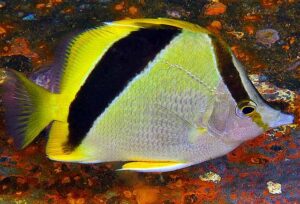
Prognathodes aya. Photo by James Garin. Courtesy: Shorefishes of the Eastern Pacific Online Information System. https://biogeodb.stri.si.edu/caribbean/en/thefishes/species/3847
Prognathodes aya (Jordan 1886) This butterflyfish (Chaetodontidae) occurs in the western Atlantic from North Carolina to the Gulf of Mexico. It was named for the Red Snapper, Lutjanus aya (now known as L. campechanus), from whose stomach the holotype was — and these are Jordan’s words, not ours — “spewed up.”
Leuroglossus callorhini (Lucas 1899) This deep-sea smelt (Bathylagidae) from the Bering Sea is named for the Northern Fur Seal, Callorhinus ursinus, which “extensively” feeds on this species and from whose stomach the type material was collected. “Owing to the tenderness and small size of this fish,” Lucas wrote, “it is so quickly acted on by the gastric juice that nothing but bones remained of the many hundred specimens that were seen and while evidently common, it can be described only from the skeleton.”
Neopagetopsis ionah Nybelin 1947 The biblically inspired name of this crocodile icefish, discovered from the stomach of a whale, is covered in the 29 January 2020 “Name of the Week.”
Hyporthodus exsul (Fowler 1944) The name of this rare grouper from the western coast of Mexico and Central America means “exile.” Why? Because the holotype was exiled to the stomach of a Black Skipjack Tuna, Euthynnus lineatus.
Our runner-up favorite:
Ethadophis merenda Rosenblatt & McCosker 1970 This snake eel (Ophichthidae) from Baja California, Mexico, was taken from the stomach of a White Sea Bass, Cynoscion nobilis. “Merenda” is Latin for “afternoon snack.” Its common name is Snack Eel.
Our favorite:
Paraliparis infeliciter Stein, Chernova & Andriashev 2001 This South Australian snailfish (Liparidae) is known from only one specimen eaten by an Orange Roughy, Hoplostethus atlanticus. Its Latin name means “bad luck.”

Live coloration of Paracanthopoma saci. From: Dagosta, F. C. P. and M. de Pinna. 2021. Two new catfish species of typically Amazonian lineages in the Upper Rio Paraguay (Aspredinidae: Hoplomyzontinae and Trichomycteridae: Vandelliinae), with a biogeographic discussion. Papéis Avulsos de Zoologia (São Paulo) v. 61: e20216147: 1-23.
25 August
Paracanthopoma saci Dagosta & de Pinna 2021
The name of this new species of vandelliine catfish has a clever double meaning.
Paracanthopoma saci is known only from the Rio Taquarizinho, a tributary of the Rio Taquari in Rio Paraguay drainage of Mato Grosso do Sul, Brazil. It occurs over fine sand in clear, slightly milky water 30 to 150 cm deep. The elevation of the stream is 363 meters.
The specific epithet saci is an acronym, named for the SACI expedition — South American Characiform Inventory — which collected the first known specimen of this species. But that is only half the name’s meaning. “Saci” also refers to saci-pererê, the name of a supernatural entity in Brazilian folklore personified as a nocturnal, one-legged, hopping, red-capped, pipe-smoking boy who turns into dust devils and is fond of terrorizing or at least annoying people and other animals.
Paracanthopoma saci clearly annoys other animals. It’s a member of the trichomycterid subfamily Vandelliinae, which the authors of the description categorize as the “only exclusively hematophagous gnathostomes besides vampire bats.” In other words, they feed on blood. Vandelliines enter the gill cavity of larger fishes, lacerate a blood vessel, gorge on blood, and leave. Annoying, indeed.
Vandelline catfishes terrorize humans as well. They are reputed to enter the urethra and vaginal canal of human bathers. Most accounts have been discredited as myth or superstition. A modern account reported in a medical journal is disputed. But still, the thought of a vandelline catfish swimming up your privates is enough to make you cringe and think twice about what you do in the water.
Saci-pererê would no doubt approve.

Paraliparis freeborni. From: Stein, D. L. 2012. A review of the snailfishes (Liparidae, Scorpaeniformes) of New Zealand, including descriptions of a new genus and sixteen new species. Zootaxa No. 3588: 1-54.
18 August
Paraliparis freeborni Stein 2012
What do the film Saving Private Ryan and the four-volume book Fishes of New Zealand have in common? They both contain contributions from artist Michelle Freeborn.
Freeborn studied art and design in England. She then went on to work in the British Film Industry for 15 years in special make up, costume and model making. Her credits include “art finish and hair punching” for Steven Spielberg’s Saving Private Ryan, and foam and latex fabrication for Lost in Space. (What is hair punching? It’s the application of individual hairs onto prosthetic makeup appliances.)
In 2001, Freeborn moved to New Zealand and learned about a job at Te Papa Tongawera, the Museum of New Zealand, illustrating fishes for an upcoming book. She knew nothing about fishes but that didn’t stop her from applying for the job. She bought a fish at a local market — the Red Gurnard Helicolenus percoides — drew it, and presented it during her interview. Andrew Stewart, the fish collection manager at Te Papa, said: “It was very obvious that she has identified and captured the essence of a difficult species very clearly.” She got the job.Freeborn perfected her technique over the next month. In many cases she was able to go from a blank sheet to a finished drawing in a single day. Stewart said: “With growing confidence Michelle has started to observe characters and morphologies which had escaped even the experts. In some cases we have had to revise our identifications.”
One of Freeborn’s biggest fans is snailfsh (Liparidae) taxonomist David L. Stein. In 2012, he named a snailfish — known only from the holotype, taken on the Chatham Rise off New Zealand at a depth of 1218 m — in her honor. She illustrated 34 species for Stein, for a total of 83 drawings. These included not only fully detailed lateral views, but also drawings of anatomical details and internal structures after dissection.
Stein later wrote: “She is efficient, patient (important when a drawing must be repeatedly revised to get it perfect), precise, and a pleasure to work with. Furthermore, she is a quick study — fish anatomy is an exacting discipline, and requires that the artist understand what is being drawn and its function, so that it can be properly rendered. Once the function of an anatomical feature has been explained to Michelle, she applies that knowledge to future drawings.”
You can sample some of Freeborn’s work, cinematic and ichthyological, at her website. You can watch Freeborn demonstrate her technique here:
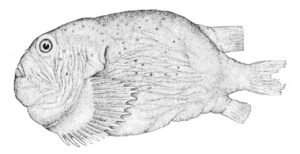
Aptocyclus ventricosus. From: Hart, J. L. 1973. Pacific fishes of Canada. Bulletin of the Fisheries Research Board of Canada Bull. 180: 740 pp.
11 August
The potbellied, urine-squirting lumpfish that’s also a pervert (allegedly)
Poor Aptocyclus ventricosus. First of all, it’s called a lumpfish. The Smooth Lumpfish. Or, even worse, Smooth Lumpsucker. Neither “lump” nor “sucker” conjures images of a sleek, fast-swimming predator that puts up a fight when hooked and tastes great when grilled with chili powder and a wedge of lime. Nor does it sound like a perky, bright-colored denizen of a coral reef. Instead, it’s a globular, scaleless, muddy-gray fish that inhabits the cold, deep waters (up to 1700 m) of the North Pacific.
The “sucker” part of its name refers to its ventral fins, which are joined to form a circular adhesive disc, a fact reflected in its generic epithet: [h]apto, to fasten or bind, and cyclos, circle or ring. The “lump” part alludes to its inclusion in the lumpfish family Cyclopteridae (also named for the adhesive disc-like ventral fins). Many lumpfishes have a first dorsal fin so enveloped by a thick and tubercular skin that it looks like a lump instead of a fin, hence the moniker. The Smooth Lumpsucker has no such lump. Its first dorsal fin is completely embedded in the skin. The second dorsal fin looks pretty much normal.
The specific name “ventricosus” dates to naturalist and explorer Peter Simon Pallas (1741-1811), who described the species in 1769. Pallas, as far as we can tell, had no first-hand knowledge of the fish. Instead, he based his description on an unpublished manuscript written by Georg Wilhelm Steller (1709-1746), a German physician-naturalist who explored the Kamchatka Peninsula and what is now Alaska in 1740 and 1741, during which he discovered lots of animals, including this fish. “Ventricosus” is Latin for potbellied or bulging. Steller described the fish as having two exceedingly large urinary bladders, which, per Pallas, can cause an “unsightly belly size” (translation). When Steller pressed the belly, he said the fish squirted urine.
While skimming through Pallas’ Latin text for the meaning of “ventricosus” we came across a passage that stopped us in our tracks. “What the [expletive]?” we muttered. Surely our poor attempt at translation was deceiving us. We consulted two scholars fluent in Latin, Holger Funk and Ron Fricke, who confirmed what our eyes could scarcely believe. According to Steller, via Pallas:
“There is an absurd accusation among the people of Kamchatka who consider this fish libidinous and lewd because it always has its eyes turned upwards in order to catch a glimpse of the sacellum [little sanctuary] under the skirts of ladies bathing at the beach.”
Lawyers for the Smooth Lumpsucker deny the allegation.
4 August
Hypostomus guajupia Penido, Pessali & Zawadzki 2021
It is one of the largest mining disasters ever. On 25 January 2019, Dam I, a tailings dam at the Córrego do Feijão iron ore mine, near Brumadinho, Minas Gerais, Brazil, collapsed. A tailings dam is an embankment used to store, presumably forever, the highly toxic metal wastes that are generated as iron-ore is extracted from the ground. But the Brumadinho dam’s lifespan fell tragically short of forever. Just after noon, at 12:28 PM, the dam collapsed. An estimated 12 million cubic meters of toxic waste and mud swept through the mine’s offices (including a cafeteria where employees were eating lunch), and through homes, farms, inns, and roads downstream. At 3:50 p.m., the mud reached the Paraopeba River, which supplies water to one third of the Greater Belo Horizonte region.
The collapse killed 270 people, of whom 259 were officially confirmed dead. The bodies of 11 others have not been found. In addition, the collapse caused fish death, habitat loss through siltation, increased turbidity, heavy metal contamination, and temporary oxygen depletion in the Rio Paraopeba.
Hypostomus guajupia is a new species of loricariid catfish that occurs in the Rio Paraopeba, directly within the dam’s path of destruction. The authors named it after Guajupiá, the Tupí-Guaraní name for a mythical place analogous to the Fields of Reeds for the ancient Egyptians, the Elysian Fields for the classical Greeks, and Heaven for Christians, a “place beyond the mountains, where the righteous souls would meet their ancestors and live eternally in health, justice, pleasure and joy,” in tribute to the 270 people who died when the Brumadinho dam collapsed.
The impact of the dam disaster on the population status of Hypostomus guajupia — and for the freshwater biota of the region as a whole — are not yet known.
In September 2019, Brazilian police indicted Vale, the mining company that owns the dam, the testing service TÜV SÜD, and 13 employees of the two companies for producing misleading documents about the safety of the dam. The precise cause of the collapse has not yet been determined, but experts agree that tailings dams are extremely vulnerable to liquefaction when the tailings behind the dam are saturated with water. The liquid mixture erodes the structure of the dam and increases the potential for a rupture.
Brumadinho was not the first tailings dam disaster in Brazil. On November 5 2015, a tailings dam at the Germano iron ore mine near Mariana, also in Minas Gerais, suffered a catastrophic failure. Although fewer people died (19), the environmental devastation from the collapse is the largest ever recorded, with pollutants spreading along 668 km (415 m) of watercourses.
There are over 1700 tailings dams worldwide. Of them, 687 of them are classified as “high risk” if their collapse would cause extreme or catastrophic danger to nearby communities, including mass fatalities.
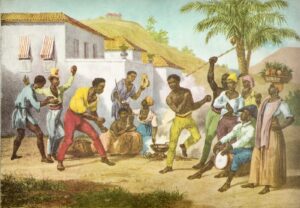
Capoeira or the Dance of War, painting by Johann Moritz Rugendas, ca. 1825.
28 July
The Capoeira Catfishes
The authors of two new species of loricariid catfishes from Brazil must be fans of the Brazilian martial art capoeira. Because they named them after master practitioners — capoeiristas — of the “Dance of War.”
Capoeira has a fascinating history. It was created by Africans and African descendants enslaved by Portuguese colonists in 16th– to 19th-century Brazil. The Portuguese forbade the slaves to practice any kind of fighting that could one day be used against them. They also forbade any displays of traditional African customs. So the slaves created something new, a form of combat disguised as dance. When the Portuguese were present, it seemed the slaves were dancing. When the slaves were alone, the original intentions of capoeira became clear: learn, practice and perfect combat skills that can one day be used against their captors. The word “capoeira” is said to derive from the Tupí words ka’a (forest) and paũ (round), referring to areas of low vegetation in the Brazilian interior where fugitive slaves would hide.
When slavery was declared illegal in Brazil in 1888, many free former slaves were abandoned. There was nowhere to live. Jobs were scarce. They were despised by Brazilian society. Desperate for food and money, many capoeiristas turned to crime, working for criminals and warlords as body guards and assassins. Capoeira was declared illegal. Anyone caught practicing capoeira, even for fun, would be arrested, tortured and often mutilated by the police. By the 1920s, strictures against capoeira began to ease. It was legalized in 1930.
The two new “Capoeira Catfishes” were described by Cláudio Henrique Zawadzki and Iago de Souza Penido in the journal Ichthyological Exploration of Freshwaters (24 June 2021). Both species are currently only known from the main channel of the Rio São Francisco downstream of Paulo Afonso IV dam, at the border of Bahia and Alagoas States, Brazil.
Hypostomus bimbai is named in honor of José Manoel dos Reis Machado (1899-1974), commonly called Mestre Bimba, i.e., a master capoeirista. He created the Regional style of capoeira characterized by more acrobatic moves and more aggressive punches, and was responsible for the legalization of capoeira in 1930.
Hypostomus pastinhai is named in honor of Vicente Joaquim Pereira (1889-1981), aka Mestre Pastinha. He was the “symbolic patron” of the Angola style of capoeirista, which is characterized by being more rhythmic, slow and malicious, with somewhat creeping movements low to the ground.
These are not the first fishes named for a capoeirista. In 2016, Peixoto & Wosiacki described Eigenmannia besouro, a knifefish (Gymnotiformes: Sternopygidae). “Besouro” is Portuguese for beetle, named in honor of Manoel Henrique Pereira (1895-1924), known as Besouro Mangangá (The Mangangá Beetle), a native of the Recôncavo region of Bahia, Brazil (where this knifefish occurs), and a legendary capoeirista.
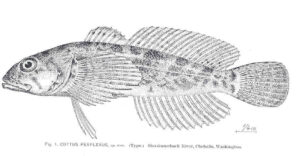
Cottus perplexus. From: Gilbert, C. H. and B. W. Evermann. 1894. A report upon investigations in the Columbia River basin, with descriptions of four new species of fishes. Bulletin of the U. S. Fish Commission v. 14 (art. 16) (for 1894): 169-207, Pls. 16-25.
21 July
Cottus perplexus: a perplexing name
The Reticulate Sculpin Cottus perplexus occurs in freshwater Pacific-slope streams in Washington, Oregon, and northern California, USA. Its name, perplexus, has two definitions: (1) perplexing, confusing, ambiguous, or puzzling, and (2) entangled, interwoven, involved or intricate. Which meaning did the authors, Gilbert & Evermann 1894, have in mind? They did not say.
When considering the meaning of an ambiguous name, we look to see if the same name has been used by other taxonomists, be it for fishes, plants, insects, and so forth. Among fishes, the adjective perplexus has been used three other times. In chronological order they are:
- Eustomias perplexus Gibbs, Clarke & Gomon 1983, a barbled dragonfish from the Western Pacific of China and Papua New Guinea — name means puzzling, referring to its “perplexing combination” of characters seen on two related species, E. longibarba and E. curtatus
- Hyporthodus perplexus (Randall, Hoese & Last 1991), a grouper from Cape Moreton, Queensland, Australia — name means puzzling, referring to its “many peculiarities” (per Randall et al. 1993): known from only a single specimen and “surprising” that more have not been found; lack of additional specimens; and “puzzling” absence of any highly diagnostic characters, apart from its unusually low (13) number of soft dorsal-fin rays
- Scopelogadus perplexus Kotlyar 2021, a bigscale (Melamphaidae) from equatorial and tropical waters of the Pacific — name means confusing or ambiguous, referring to how it had been misidentified as two other species of the genus, S. mizolepis and S. bispinosus
Note that in all three examples, the perplexus adjective refers to some sort of taxonomic confusion about the fish. But the authors of Cottus perplexus did not indicate any such uncertainty or ambiguity in their description. Their account clearly differentiates this sculpin from its closest congener, C. punctulatus. Gilbert & Evermann even say its “body is deeper and more compressed than in any other species known to us …”. From a taxonomic standpoint, there’s nothing perplexing about it.
Which brings us to the second meaning of perplexus — entangled, involved, intricate, etc. Might this adjective refer to the fish’s color pattern? Here’s how the authors described it:
Color in alcohol, back and sides with vermiculations of light and dark, the back with 5 or 6 ill-defined black crossbars, which usually reach the lateral line; the usual black bar at base of caudal, emarginate posteriorly; below the lateral line a number of small, quadrate, dark blotches, arranged in two irregular series; lower parts unmarked except with fine dark punctulations; dorsal, pectoral, and caudal fins crossbarred with dark; anal and ventrals with numerous small dark specks.
Whether this describes an “intricate” or “complex” color pattern — a highly subjective assessment — is impossible to say. The illustration the authors provided (shown here) does not show an intricately patterned fish in our opinion.
Ichthyologist Peter B. Moyle was perplexed by the name. In his excellent book Inland Fishes of California (2nd ed., 2002), his attempt to explain the name clumsily covers both explanations: “Perplexus translates as perplexing,” he wrote, “reflecting the difficulty in defining the species, although Gilbert and Evermann may have had the reticulated appearance in mind when assigning the name.”
Another perplexity: We don’t know who coined the common name Reticulated Sculpin for this species, but it does not seem reticulated (arranged or marked like a net or network) to us. The authors described vermiculations (marked with sinuous or wavy lines), not reticulations.
And yet another perplexity: The junior author of the name, Barton Warren Evermann, was also the junior author of the four-volume Fishes of North and Middle America. In volume two (1898), he and senior author David Starr Jordan explained that perplexus means “perplexed.” Not perplexing. Perplexed. Note the difference. “Perplexing” connotes that there is something about the sculpin that is confusing to those who study it. “Perplexed,” however, suggests that it is the sculpin itself that is confused or troubled by deep uncertainty. We pondered this for a bit but dismissed it as silly.
All we can say with any confidence is that the name perplexus describes itself. And those who attempt to explain it.
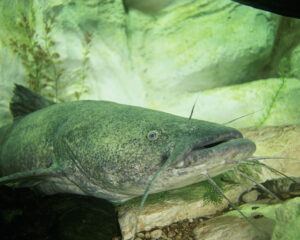
Pylodictis olivaris. Photo by Eric Engbretson, U.S. Fish and Wildlife Service.
14 July
Pylodictis — real and imagined
Pylodictis — with one species, the very real Flathead Catfish of North America — may be the only valid genus named after an imaginary fish.
Constantine Rafinesque (1783-1840) described the Flathead Catfish as Silurus olivaris, from the Ohio River, in 1818. Silurus was a catch-all genus for freshwater catfishes, and olivaris means olive-colored, referring to its body color, which Rafinesque described as “olivaceous, shaded with brown.” The next year Rafinesque described another catfish from the Ohio River, which he named Pylodictis limosus.* The meaning of the generic name requires a little guesswork, especially since Rafinesque took a careless (or creative, depending on your point of view) approach to the spelling of Greek and Latin words. Pylodictis is probably a combination of pelos (Greek for mud) and ictis, a variant spelling of ichthys (Greek for fish), with the “d” likely inserted for euphony. The specific epithet, limosus, is Latin for muddy. Both parts of the name reflect two of the common names Rafinesque reported for the fish — Mudcat and Mudsucher (Mudsucker) — and the fact that it “lives in the mire” (“vit dans la fange”).
For reasons unexplained, Silurus olivaris does not appear in Rafinesque’s Ichthyologia Ohiensis (1820), whereas Pylodictis (now spelled Pilodictis) limosus — called the “Toad Mudcat” — gets a more detailed account, this time in English. “I have not seen this fish,” Rafinesque wrote, “but describe it from a drawing of Mr. Audubon. It is found in the lower parts of the Ohio and in the Mississippi, where it lives on muddy bottoms, and buries itself in the mud in the winter. It reaches sometimes the weight of 20 pounds. It bears the name of Mudcat, Mudfish, Mudsucker, and Toadfish. It is good to eat and bites at the hook.”
Mr. Audubon is John James Audubon (1785-1851), the famous American ornithologist, painter, and namesake of the National Audubon Society. In 1818, Rafinesque was a guest at Audubon’s Kentucky home. In the middle of the night, Rafinesque noticed a bat in his room that he thought was a new species. He grabbed Audubon’s favorite violin in an effort to knock the bat down. We do not know the fate of the bat. The violin, however, was destroyed.
In 1877, David Starr Jordan reviewed Rafinesque’s contributions to American ichthyology. He determined that Silurus olivaris was the senior synonym of Pylodictis limosus. Since the catfish was distinct enough to warrant its own genus, Jordan settled on Rafinesque’s Pylodictis, the oldest available name. Silurus olivaris thus became Pylodictis olivaris (although Jordan attempted to correct Rafinesque’s spelling, unnecessarily changing “Pylodictis” to “Pelodichthys.”)
At around this time, American naturalists were beginning to realize that Audubon had pranked Rafinesque, presumably in retaliation for the broken violin. Audubon described and/or sketched a number of fictitious, even fantastical, fishes, which the gullible Rafinesque described as real. These included a sunfish with a dorsal fin resembling that of the dolphinfish or mahi-mahi (Coryphaena), with a single long, spiny ray beginning behind the head and ending near the tail, and a 10-foot long “devil jack diamond-fish,” an alligator gar with bullet-proof scales. Jordan knew of these fabrications, but apparently not all of them.
Jordan retained the name Pylodictis, presumably unaware that the type species, Pylodictis limosus, lived only “in the mire” of Audubon’s vengeful imagination.
* Perhaps as evidence of Rafinesque’s eccentricity — or sloppiness as a taxonomist — he proposed several other names for the Flathead Catfish: Ilictis limosus, Leptops viscosus and Opladelus nebulosus.
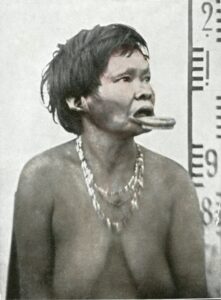
Botocudo woman (circa 1900) with the botoque in the lower lip (source: Wikipedia).
7 July
Austrolebias botocudo and Austrolebias nubium
Austrolebias are annual killifishes that live in temporary pools, swamps and streams during rainy seasons in Brazil, southwestern Bolivia, Paraguay, Uruguay, and north-eastern Argentina. During dry seasons they die while their eggs undergo diapause until the rains return. Austrolebias are usually lowland species, but between 2012 and 2017 two new species were discovered in isolated high-elevation temporary pools on private farmland in southern Brazil. Their descriptions recently appeared in the journal Zootaxa. Both were given interesting names with subtle double meanings.
Austrolebias nubium occurs in temporary pools located in highland grasslands of the rio Santana drainage, Bom Jesus municipality, Rio Grande do Sul. Its name, nubium, means “of the clouds,” referring to it occurring at the highest elevation (1000 m) recorded for any member of the genus. In addition, annual fishes in Brazil are popularly known as “peixes das nuvens” (cloud fishes) because they appear after rains in areas that were previously completely dry.
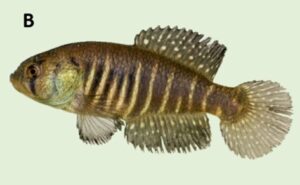
Austrolebias botocudo, male, from: Lanés, L. E. K., M. V. Volcan and L. Maltchik. 2021. Two new annual fishes (Cyprinodontiformes: Rivulidae) unexpectedly discovered in the highlands of southern Brazil. Zootaxa 4949 (no. 3): 499-520.
Austrolebias botocudo was found in just two temporary grassland pools, 926 and 934 meters above sea level, Vacaria municipality, also in Rio Grande do Sul. It is named for the indigenous people who formerly inhabited the region. They were called “Botocudos” in the 19th century because adults used a botoque (a plug-like wooden disk) to enlarge the lower lip. The name also refers to the fish’s lower jaw, which seems more prominent than other closely-related congeners.*
Because of their extremely small ranges and fragmented habitats — in grasslands used extensively for cattle ranching, soybean crops, and apple and pear orchards — both species are considered Critically Endangered.
* A Brazilian catfish, Glanidium botocudo Sarmento-Soares & Martins-Pinheiro 2013, is also named for the original inhabitants of where it occurs, but not, as with A. botocudo, for a morphological reason as well.
 30 June
30 June
Günther Sterba (1922-2021)
On 16 June 2021, one of the giants of the aquarium hobby, Günther Sterba, passed away just a few weeks after his 99th birthday. He was the author of the 1959 classic aquarium reference, reprinted and updated many times in many languages, Süsswasserfische aus aller Welt (Freshwater Fishes of the World).
Born in Czechoslovakia, Sterba began studying medicine from a hospital bed, having been wounded in 1944 while serving in World War II. In 1947 he began studying for a second degree in zoology, which eventually became his focus. His 1949 Ph.D. dissertation was on the histomorphology of the African Clawed Frog, Xenopus laevis. He became a Professor of Zoology at the University of Leipzig and Director of their Zoological Institute in 1959, where he retired as a professor emeritus in 1987. Most of his research and academic publications were in three subject areas: (1) the genesis and structure of incretory organs in lower vertebrates, (2) comparative neuroendocrinology in vertebrates, and (3) circumventricular organs and cerebrospinal fluid in vertebrates.
Sterba maintained aquaria during his youth. His love for the hobby matured as he matured, culminating in the 1959 publication of Süsswasserfische aus aller Welt. Three years later an English version was published, translated and updated by Denys W. Tucker, recently fired by the Natural History Museum of London for believing the Loch Ness Monster was real (see the 1 Jan. 2020 “Name of the Week”). Professional ichthyologists were impressed with Sterba’s knowledge. Peter J. P. Whitehead of the British Museum (Natural History) praised the book in a scholarly journal, the Annals and Magazine of Natural History. This is how he opened his review:
What contribution does the aquarist make towards the science of ichthyology? Observation alone is not science, merely one of the steps involved; it leads to an accumulation of data. Science persues relevant observations, relevant that is to an existing hypothesis, correlates and compares, tests and adjusts — then pronounces. In recent years, some studies (fish behaviour, genetics) have certainly originated from aquarists’ observations. Of value to the ichthyologist too has been the ever-growing body of empirical data relating to practical fish-rearing and breeding techniques. Any truly scientific work which helps to systematize the aquarist’s know-how will benefit both aquarist and ichthyologist. Günther Sterba’s Süsswasserfische aus aller Welt is such a work.
Three fishes have been named in Sterba’s honor. In 1962, Sterba’s friend Joachim Knaack, a physician, aquarist and amateur ichthyologist, described Corydoras sterbai, a popular aquarium catfish. In 1997, Axel Zarske, one of Sterba’s many students, named a darter characin, Geryichthys sterbai, on the occasion of Sterba’s 75th birthday. Zarske again honored Sterba for his 90th birthday in 2012 with the name of the Seven-Rayed Mint Tetra, Serrapinnus sterbai.
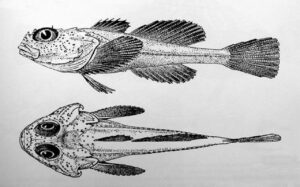
Artediellichthys nigripinnis. From: Schmidt, P. Yu. 1950. Fishes of the Sea of Okhotsk [= Ryby Okhotskogo morya]. Transactions of the Pacific Committee of the Academy of Sciences of the U.S.S.R. v. 6: 1-370, Pls. 1-20.
Artediellichthys Taranetz 1941 is now Artediellichthys Fedorov 1973
According to ICZN Art. 13.3, every new genus-group name published after 1930 must be accompanied by the fixation of a type species in the original publication (or be expressly proposed as a new replacement name) in order for that name to be available. While researching the name of the sculpin genus Artediellichthys — with one species, A. nigripinnis — we discovered that the ichthyologist credited with proposing the name, Anatoly Yakovlevich Taranetz (1910-1941), did not include a species. And, so, we scoured the literature looking for the first available use of the name.
Artediellichthys nigripinnis, the Blackfin Hookear Sculpin, occurs in North Pacific waters between Russia and Alaska, including the Sea of Okhotsk, the Bering Sea, and the Gulf of Alaska, at a depth of 200 to 815 meters. It reaches 13.7 cm TL. Soviet ichthyologist Petr Yulievich Schmidt (1872-1949) described the species as Artediellus nigripinnis in 1937, naming it for its black dorsal and anal fins, and blackish ventral and pectoral fins (niger, black; pinnis, fin). In 1941, Taranetz proposed a new subgenus of Artediellus, distinguished (in part) by a plate-like (broad and spatulate) rather than a stick-like (narrow and round) suborbital stay. He named the subgenus Artediellichthys.
Unfortunately, Taranetz did not specifically indicate that Schmidt’s A. nigripinnis belonged to this subgenus (although it was clear within the context what his intentions were). The fact that his description did not comply with ICZN Art. 13.3 had been noted by Eschmeyer’s Catalog of Fishes, which provisionally accepted Taranetz as the author of the name with the caveat “Needs more work.”
We did the needed work and found that the first publication to unambiguously link A. nigripinnis with Artediellichthys was “A list of Bering Sea fishes,” written by Vladimir Vladimirovich Fedorov (1939-2011) and published in 1973. Fedorov had actually credited authorship of the taxon to Schmidt’s original 1937 description of A. nigripinnis, but Fedorov was wrong: Schmidt had only mentioned that his colleague Taranetz was planning to describe a new subgenus for A. nigripinnis without actually naming what that subgenus would be called.
Long, needlessly complicated story short: Fedorov 1973 became the unintentional “author” of a name that entered the literature 32 years earlier.
The name itself, Artediellichthys, is an example of how some taxonomists name closely related genera by giving them similar names that connote their close affinity. Artediellichthys was proposed as subgenus of Artediellus (Artediellus + ichthys, fish). Artediellus Jordan 1885 is a diminutive of Artedius, a similar genus from which it differs chiefly in the naked skin of head and body. Artedius was described by Charles Girard (1822-1895), in 1866; he did not explain the meaning of the name, but it is almost certainly in honor of Swedish naturalist Peter Artedi (1705-1735), known as the “father of ichthyology.”
Other related genera and subgenera are Artediellops Neelov 1979 (ops = appearance), Artedielloides Soldatov 1922 (-oides = having the form of), and Artediellina Taranetz 1937 (-ina = having the nature of).
Artediellina Taranetz 1937 is another unavailable name that “needs more work.”
We’re on it.
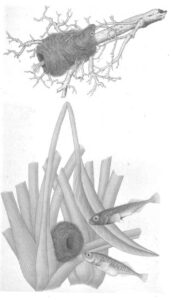
Top: Male Pungitius pungitius rotating its body to form a cylindrical nest. Bottom: The female entering the nest to deposit her eggs. From: Coste, J. 1848. Nidification des épinoches et des épinochettes. Mémoires Présentés par Divers Savants à l’Académie des Sciences de l’Institut de France, Sciences Mathématiques et Physiques (Ser. 2) v. 10: 574-588, 1 pl.
16 June
Pungitius Coste 1848 is now Pungitius d’Annone 1760
This is the 400th weekly “Name of the Week.” We haven’t missed a week since we started writing and posting these mini-essays on Wednesday, 17 October, 2013. We never thought we’d still be cranking out these posts over 7½ years later. Nor did we suspect that our curiosity about the meanings of fish names would have any permanent influence on nomenclature. But it has. As recorded in previous NOTWs, our work has led to numerous spelling corrections, date changes, and changes of authorship, all now accepted by the “bible” of fish nomenclature, Eschmeyer’s Catalog of Fishes. Here is a recent discovery: that the authorship of a genus long attributed to one naturalist in 1848 actually belongs to another naturalist writing 88 years earlier.
Before we plunge into the details, let’s define what we mean by “authorship.” The author of a name is not the person (or persons) who described the taxon in question and/or coined its name, although in most cases it is. Instead, the author is the person(s) who first made the name available by publishing it in a manner meeting the requirements of the ICZN “Code.” These requirements have gotten more stringent over the years, so the question of authorship is rarely a problem for modern-day nomina. But for many names published in the early days of Linnaean nomenclature, a full description — diagnostic characters, designated type species, etc. — were not requirements as they are today. Names could be made available with only cursory mentions in the literature. That’s what happened with this one. Twice, in fact.
Pungitius Coste 1848 has long been the genus/author/date combination for the Ninespine Sticklebacks of Europe and North America. Coste was Jean Jacques Victor Coste (1807-1873), a French biologist and fisheries inspector who wrote a paper on the nest-building behaviors of sticklebacks. At that time, all sticklebacks were placed in the genus Gasterosteus Linnaeus 1758, including the Ninespine Stickleback, G. pungitius Linnaeus 1758. But Coste observed that while the Threespine Stickleback G. aculeatus Linnaeus 1758 built an uncovered nest on the substrate, the Ninespine built a nest hidden with the leaves of aquatic plants (see Coste’s illustrations, shown here). This, in his opinion, justified the separation of the sticklebacks into two genera, Gasterosteus and Pungitius. Instead of coining a new generic name for the Ninespine, Coste simply created a tautonym, in which the generic name repeats the trivial — Pungitius pungitius, derived from the Latin word for “pricking,” referring to the fish’s dorsal and pelvic spines. (The modern-day adjective “pungent” derives from pungitius also). Linnaeus did not coin the name; instead, he repurposed a name that had been used for sticklebacks since at least the Renaissance. The earliest reference we found is “Pungitio Alberti,” from Historiae naturalis de quadrupetibus libri (1649), by the Polish scholar and physician Jan Jonston (1603-1675).
By today’s standards, establishing a new genus based on behavior is unacceptable, but was good enough in 1848. Since Coste’s paper was the earliest known use of “Pungitius” as the name of a genus, Coste was considered the “author” of the name, especially after David Starr Jordan gave the name his blessing in his “A Classification of Fishes” of 1924. (Note: Jordan gave Coste’s first-name initial as “P.” instead of a “J.”, an error that we hereby correct.)
A comment in Eschmeyer’s Catalog of Fishes inspired us to dig a little deeper. According to Eschmeyer, ichthyologist Henry Weed Fowler, in his largely unpublished “Fishes of the World” (a precursor to the Catalog), had recorded “d’Annone 1760” as the author of the genus. Eschmeyer added the note, “not investigated” — an invitation for us to do just that. Thanks to the digitization and online availability of many old, obscure natural history publications, we were able to find “d’Annone 1760” after a few clicks of the mouse. Written by Swiss archaeologist and naturalist Jean Jacques d’Annone (1728-1804), the article is a series of observations d’Annone recorded while watching sticklebacks and worms in a Swiss stream in April 1758. Sure enough, d’Annone had latinized Jonston’s “Pungitio Alberti” as Pungitius alberti (now a junior synonym of P. pungitius), following the then-novel binominal genus/species construction Linnaeus had proposed. This, as Fowler had suspected, was the earliest available use of Pungitius as a genus-level name. We sent a PDF to the editors of Eschmeyer’s Catalog and they agreed.
We have another authorial change from our etymological research. That will be the subject of “Name of the Week” #401.
9 June
Phytichthys chirus (Jordan & Gilbert 1880)

Phytichthys chirus. © Joseph R. Tomelleri. From: Pietsch, T. W. and J. W. Orr. 2019. Fishes of the Salish Sea. Seattle: University of Washington Press.
Perhaps the best fish book in recent years is Fishes of the Salish Sea (2019), by ichthyologists Theodore W. Pietsch and James W. Orr, with illustrations by the incomparable Joseph R. Tomelleri (such as the one shown here). This three-volume set covers the marine and anadromous fishes of inland marine waters of Washington State and British Columbia, specifically Puget Sound and the Straits of Georgia and Juan de Fuca. The name “Salish Sea” — in recognition and tribute to the Salish people, with whom virtually all the indigenous tribes in the region have links and probably a common origin — is the collective term for these waters.
One of the reasons we like the book so much is that it gives weight to the etymology of each species’ name. This has proven especially useful as we’ve researched the names of rockfishes, eelpouts, sculpins, and other fishes especially common in the northeast Pacific. Take, for example the generic name of the Ribbon Prickleback, Phytichthys chirus. This 21-cm intertidal fish occurs in waters less than 12 m deep from the Aleutian Islands and Gulf of Alaska to Southern California. The genus was named by Carl Hubbs in 1923. Phytos means plant and ichthys, of course, means fish, but Hubbs did not indicate the reason for the “plant” part of the name. Authors Pietsch and Orr helpfully explain that the name was given to “denote a fish with a strong predilection for living among and consuming algae.”
Pietsch and Orr’s explanation for the specific name chirus, however, falls a little short. Coined by David Starr Jordan and Charles Henry Gilbert in 1880, Pietsch and Orr correctly say the name is derived from Greek cheiros, meaning “hand,” often used by ichthyologists to refer to a fish’s pectoral fins, homologous to the hands or forepaws of mammals. But then they say, “… exactly how ‘hand’ relates to the species is unknown, and its authors provided no explanation.”
Jordan and Gilbert did, in fact, explain the name, or at least provided a hard-to-miss clue. They had initially placed the species in the genus Xiphister, noting its “quite small” pectoral fin, “but several times larger than in any of the other species, larger than the eye, its length about equal to the distance between the middle and lower lateral lines.” To emphasize the diagnostic importance of the pectoral fins — the “hands” of the fish — Jordan and Gilbert emphasized the phrase “but several times larger than in any of the other species” by placing it in italics.
Phytichthys chirus is the “plant” (algae-loving) fish with hands (large pectoral fins).
For all the help Fishes of the Salish Sea has given us, we’re happy to return the favor.
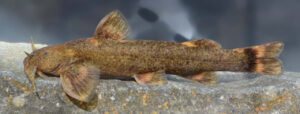
Glyptothorax daemon. From: Freyhof, J., C. Kaya, Y. S. Abdullah, and M. F. Geiger. 2021. The Glyptothorax catfishes of the Euphrates and Tigris with the description of a new species (Teleostei: Sisoridae). Zootaxa 4969 (3): 453–491.
2 June
Glyptothorax daemon Freyhof, Kaya, Abdullah & Geiger 2021
Fishes named after demons, ghosts or evil spirits usually have interesting stories behind their names. (See Satanoperca daemon, NOTW, 3 January 2018.) The name behind this recently described catfish has no story at all.
Glyptothorax daemon occurs in headwater streams in the upper Tigris and Great Zab drainages of Turkey and Iraq, in fast current and a substrate composed predominantly of rocks and gravel. Like other Glyptothorax catfishes, G. daemon is adapted to life in fast-flowing water, possessing an adhesive apparatus on its thorax by which they attach themselves to rocks to prevent being washed downstream.
The etymology section of its description reads: “The specific epithet is latinised from the Greek adjective [a noun, actually] δαίμων usually interpreted as a ghost. A noun in apposition.”
That’s all it says. The reason why this catfish is named after a demon or a ghost is not explained.
Seeking an answer, I emailed the description’s senior author, Jörg Freyhof. The name refers to the catfish’s cryptic behavior, he said, how it always hides in deep substrate.
Here’s the part that surprises me. Dr. Freyhof said that he and his co-authors had explained the meaning of the name in their original draft of the description, “but this was seen as un-needed by reviewers, so we deleted it.”
So, according to these reviewers, explaining how a name translates is a necessary part of a new-species description. Explaining what the name means, however, is not.

Solomon Markovitch Herzenstein, date unknown.
26 May
Herzensteinia microcephalus, the new highest-living fish
In December 2017, the “Name of the Week” featured the deepest- and highest living fishes — Pseudoliparis swirei (a snailfish occurring at 8178 m below sea level in the Pacific Ocean’s Mariana Trench) and Triplophysa stolickai (a stone loach occurring at 5200 m above sea level in hot springs of Tibet). Now, according to a recent paper published in the Journal of Applied Ichthyology, Chinese ichthyologists have found an even higher-living fish, Herzensteinia microcephalus, in Chalaiburkun Chu, a headwater of Dri Chu of the southern tributaries of the Yangtze River, at an elevation of 5350 m in the North Slope of the Tanggula Mountain on the Qinghai-Tibet Plateau.
Herzensteinia microcephalus is a mountain barbel of the cyprinid (carp or minnow) subfamily Schizopygopsinae. It was described as Schizopygopsis microcephalus by Russian ichthyologist Solomon Markovich Herzenstein (1854-1894) in 1891. The specific name translates as micro-, small, and cephalus, head, referring to its smaller head compared with Schizopygopsis guentheri (=S. pylzovi), its presumed closest relative at the time. Ichthyologist Yuanting T. Chu honored Herzenstein’s contribution when he proposed the genus Herzensteinia for Schizopygopsis microcephalus in 1935, stating that the fish’s single row of shovel-shaped teeth is unique among its closest relatives. (In 2019, molecular taxonomists sunk Herzensteinia back into Schizopygopsis, a paper I did not know about until an hour ago and choose to temporarily ignore for the sake of this entry.)
Any regular reader of “Name of the Week” would know, this is where I like to close the entry with a surprising, scandalous, or tragic biographical detail about the person for whom the fish is named. But I’ve found little about Herzenstein’s life beyond what’s mentioned in his Wikipedia entry. He studied natural sciences and mathematics at St. Petersburg University. In 1880 he was appointed as custodian (or curator) of the zoological museum of the Imperial Academy of Science (now the Russian Academy of Sciences). He made several scientific expeditions (in 1880, 1884 and 1887) to study the fishes and mussels the Kola Peninsula in the extreme northwest of Russia. And his numerous papers have been described as “extremely conscientious and carefully written.”
All available accounts indicate that Solomon Markovich Herzenstein was at the very top of his profession. So perhaps it is fitting that Herzensteinia microcephalus (Herzenstein 1891) is the fish that lives closest to the top of the world.
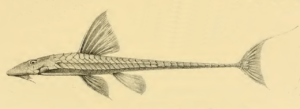
Loricaria simillima. From: Regan, C. T. 1904. A monograph of the fishes of the family Loricariidae. Transactions of the Zoological Society of London v. 17 (pt 3, no. 1): 191-350, Pls. 9-21.
19 May
Loricaria simillima Regan 1904
When an ichthyologist doesn’t provide an etymology for a name he or she has coined, I attempt to break down the Greek or Latin origin of the name, and then see if that translation relates to an attribute mentioned in the description. That’s what I did when I interpreted the name of Loricaria simillima, the Marbled Whiptailed Catfish widely distributed throughout the Amazon, Orinoco and La Plata River basins of South America. Here is the explanation I posted:
etymology not explained, presumably similis, like; lima, file or rasp, perhaps referring to similarity to Rineloricaria lima, its presumed congener at the time (although it should be noted that Regan made no such comparison; instead he noted that the species is similar to L. cataphracta)
Two days ago, I received an email from ichthyologist Donald C. Taphorn. He was working with loricariid catfishes from Guyana and one of them was similar to Loricaria simillima. So he decided to use ETYFish to see what the name means. “Since Regan didn’t say,” Dr. Taphorn wrote, “your possible explanation that it is like Rineloricaria lima is one interpretation. However, I think it could also mean ‘like a file,’ since in Spanish (and Latin) lima means file, or wood rasp, and these catfish have very rough bodies, caused by the odontodes forming raised keels on many of their body scutes.”
Last year, Dr. Taphorn had kindly corrected my interpretation of the name of the Sailfin Red Hook Silver Dollar, Myleus setiger, so I thought he was probably right again this time. However, when I took another look, I discovered we were both off the mark.
Basically, I had fooled myself into thinking that “simillima” translated as similis, like + lima, file or rasp, especially since loricariids have raspy bodies and Regan had discussed Loricaria (now Rineloricaria) lima a few pages earlier in the same publication. In so doing, I had overlooked the obvious — that “simillima” is the nominative feminine singular of the Latin adjective “simillimus,” meaning “most or very similar.” Regan said as much when he noted that the catfish is similar to L. cataphracta.
In fact, Regan used the same adjective for a mojarra he described three years later: Gerres simillimus — a Pacific species that differs “slightly” from its Atlantic congener, G. cinereus.
I hate guessing wrong. But I love it when curious, sharp-eyed readers like Dr. Taphorn questions an entry and leads me to ultimately getting the explanation right.
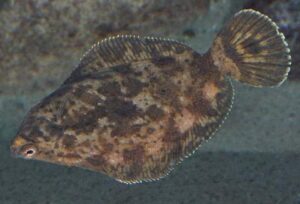
Pleuronichthys coenosus at the Steinhart Aquarium, California Academy of Sciences. Photo by D. Ross Robertson.
12 May
C-O-incidence
Pleuronichthys coenosus is a flatfish (Pleuronectidae) that lives along the eastern Pacific Ocean from Alaska to Baja California. It’s commonly called the C-O Sole because of the color pattern on the eyed-side of its caudal fin, which appears as a reverse “C” at the base of the tail followed by an “O”-like spot.
Ichthyologist-herpetologist Charles Girard (1822-1895) proposed both the genus and the species in 1854. He did not explain the meanings of the names, but they are easy to figure out. Pleuronichthys is a combination of the Greek pleura, side, and ichthys, fish, i.e., a fish that swims on its side (in this case, the left side). The specific epithet coenosus is Latin for muddy. (It can also mean filthy, foul, slimy or impure.) We suspect that Girard named it for the “deep brown” (his words) color of its body and fins.
In their superb three-volume book Fishes of the Salish Sea (2019), ichthyologists Theodore W. Pietsch and James W. Orr — with stunning illustrations by the incomparable Joseph R. Tomelleri — provide an additional, more playful interpretation of the specific name. They suggest that “coenosus” sounds out the C-O color pattern: C-O-enosus.
Unfortunately, Girard did not mention these markings in his brief 1854 description, nor in a more-detailed description he published in 1858. We suspect that any similarity between “coenosus” and “C-O” is purely C-O-incidental.
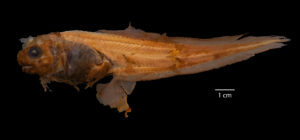
Paraliparis kadadakaleguak, holotype. Source: Oregon State University.
5 May
Paraliparis echongpachot and Paraliparis kadadakaleguak
The original descriptions tell you what the names mean. But unless you read the paper’s “Acknowledgements” section, you may not know the delightful way the names came about.
Paraliparis echongpachot and P. kadadakaleguak are two of three new species of bathyal (200-2000 m deep) snailfish (Liparidae) from the Mariana Islands, an archipelago comprising the summits of 15 mostly dormant volcanic mountains in the western North Pacific Ocean. Both names are derived from the Chamorro language of the Mariana Islands. “Echongpachot” means “crooked mouth,” referring to the fish’s oblique mouth, its angle about 20° to horizontal. “Kadadakaleguak” means “short rib bone,” referring to the fish’s short ribs. The descriptions, by David L. Stein and Bruce C. Mundy, were published online (19 April 2021) in the Japanese journal Ichthyological Research.
Thanks to a press release issued by Oregon State University (where Dr. Stein works), here’s the full story behind the etymologies.
Both names, echongpachot and kadadakaleguak, were suggested by children on Guam, the largest and southernmost of the Mariana Islands. (The third species, P. marianae, is named for the Mariana Islands.)
“Names for new species have traditionally been formed from Greek or Latin words, from the names of people who collected the specimens or from the names of other scientists to honor them,” Dr. Mundy said. “This has resulted in Euro-American names for species worldwide, a practice that is regarded by some to be colonialist or imperialist. In recent years there has been a movement to form new names from the languages of indigenous people in the areas where new species are found, to reconnect taxonomy to them.”
Students in Guam from elementary through high school age were invited to compete for the right to suggest names for the new species. Alyssa Roces from Okkodo High School suggested the name Paraliparis kadadakaleguak. Aydan Charfauros of Tamuning Elementary came up with Paraliparis echongpachot.
Dr. Stein, who has described or co-described ~125 snailfish species, says a goal when trying to coin a name is for it to be “euphonious.”
“You want a name that sounds good, and I particularly enjoy kadadakaleguak,” he said. “I just love it.”
Indeed, when we asked Dr. Stein for a PDF of the paper, telling him we would feature the names in a future “Name of the Week,” he replied: “I think kadadakaleguak is in the running for my all-time favorite fish name.”
It is certainly fun to say. Kada daka eg u ak.
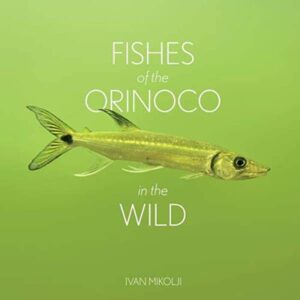
Acestrorhynchus microlepis on cover of book. Photographed August 2012 in a flooded savanna, Apure, Venezuela.
28 April
Laemolyta orinocensis (Steindachner 1879)
As its name indicates, the Black-banded Headstander (Characiformes: Anostomidae) occurs in the Orinoco River, specifically the Orinoco River basin of Venezuela, where it is endemic. I feature this name today to draw your attention to a wonderful new book to which The ETYFish Project contributed: Fishes of the Orinoco in the Wild by explorer-photographer Ivan Mikolji.
Ivan contacted me last summer asking if he could add our etymological entries to the text of a book he was planning. For the past 10+ years, he had been snorkeling and taking photographs of fishes in the clearwater streams of the Orinoco River basin of Venezuela and Columbia. He sent us his prospectus for the book and a few sample pages. I said he was free to use our etymologies as long as The ETYFish Project received credit, to which he readily agreed. In fact, I revised the entries, around 150 of them, to better fit the book’s format. Ivan was delighted.
Earlier this year, Ivan sent me my complimentary copy as soon as the book was printed. I regret not paying much attention to it when it arrived. The book got buried amongst the jumble of other books, monographs, journals, and photocopies littering my desk. Last week I finally dug it out, curled up in my favorite reading chair, and plunged in.
I was instantly transported.
Every photo is an exquisite portrait, showing the fish in its natural habitat, naturally lit by the sun, not the sterile flash of a camera. Having gotten used to seeing countless museum and aquarium photographs of fishes, Ivan’s photos are a revelation. You see the fish as it sees itself and others around it. You see the world in which it lives. You can almost feel the water around you and the sun on your back. The fish is more than just a species, a biological unit to be described, named and catalogued. It is part of something bigger, more majestic, and, somewhat contradictorily, more fragile as well.
Ivan’s brief text for each photo is also a delight to read. While he spent who knows how many hours (thousands?) patiently waiting for the right light, the right angle, and for secretive fishes to wander from their cover and allow themselves to be photographed, Ivan observed these fishes going about their daily lives. For Laemolyta orinocensis he writes:
Every time I find these fish in the wild they are eating, and they remind me of upright vacuum cleaners. They swim head down almost in a vertical position feeding on the periphyton or any fruit that has fallen into the river. During the rain periods when the streams flood the rainforest, you can find them swimming over then tree branches, biting on the leaves, and pecking on whatever silt or algae that has deposited over them. As they grow larger, they venture into the deeper more barren areas of the stream where they pick on the driftwood and fallen tree trunks, usually in small groups of up to eight.
Ivan’s text for each species is then followed by the etymology courtesy of yours truly, e.g., the genus name Laemolyta, from laemo-, throat; lyo, free, referring to the branchiostegal membranes of L. taeniata (type species), which are entirely free from the isthmus.
The scientific name is, well, scientific — clinical, anatomical, referring to the fish as seen under a dissecting microscope. Ivan’s photographs and text, however, see the fish for what it is, a living component of the sprawling canvas of life on Earth. Ivan’s photography is masterful, but his subjects, are the true masterworks of creation, each one assembled (to borrow a phrase from E. O. Wilson) with extreme care by genius.
You may sample pages and purchase the book here.
21 April
Tea, bulldogs and administrative professionals
What do these three have in common? They’re all being celebrated today (in America, at least). According to NationalDay.com, April 21 is National Tea Day. And National Administrative Professionals Day. And National Bulldogs are Beautiful Day. Of course, no one really celebrates these silly, made-up holidays. But that won’t stop us from commemorating today’s triple-special day with three fish names that fit the occasion.
Gymnotus chimarrao Cognato, Richer-de-Forges, Albert & Crampton 2008 For National Tea Day, we showcase the name of a knifefish from Rio Grande do Sul in southern Brazil. The fish is named for chimarrão, a traditional tea (Ilex paraguariensis) from the region first cultivated and enjoyed long before European colonization. Today, drinking chimarrão (popularly known as Yerba Mate) is a social ritual. Friends and family gather in a circle as the host prepares the tea in a “cuia” (gourd) and drinks the first infusion with a metal straw called a “bombilla.” The cuia is refilled and passed to each guest in the circle. Everyone shares the same cuia and bombilla, joining in a bond of acceptance and friendship. The authors selected the name because the fish’s olive-green color is similar to the color of dried chimarrão leaves.
Cuia and bombilla inspired two other tea-related knifefish names: Gymnotus cuia Craig, Malabarba, Crampton & Albert 2018, referring to the fish’s especially deep body and head, and Brachyhypopomus bombilla Loureiro & Silva 2006, named for its bombilla-like shape.
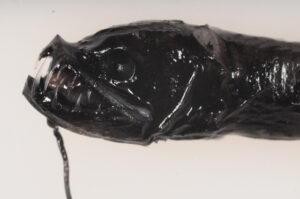
Leptostomias gladiator. Source: https://v3.boldsystems.org and Texas A&M University at Galveston.
Leptostomias gladiator (Zugmayer 1911) For National Bulldogs are Beautiful Day, we feature the name of a scaly black dragonfish (Stomiidae) that occurs in worldwide ocean waters up to 4900 meters deep. Austrian ichthyologist Erich Zugmayer (1879-1938) named it “gladiator,” a nickname for the English Bulldog. Zugmayer said the fish’s large head, with its flattened snout and prominent teeth, resembled the head of a “bouledogue.” So ugly it’s beautiful, yes?
Acanthemblemaria maria Böhlke 1961 For National Administrative Professionals Day — celebrating those called “secretaries” in earlier, less-enlightened times — we offer the name of this pikeblenny (Chaenopsidae) from the Caribbean. James E. Böhlke (1930-1982) named it in honor of Mary George, his “secretary” at the Academy of Natural Sciences of Philadelphia, “in appreciation of her assistance in all the activities” of the Academy’s Department of Ichthyology.
The common name is Secretary Blenny. Perhaps it’s time to adopt the more professional-sounding moniker Administrative Professional Blenny.

Maynea (now Oidiphorus) brevis. From: Norman, J. R. 1937. Coast fishes. Part II. The Patagonian region. Discovery Reports v. 16: 1-150, Pls. 1-5.
14 April
Sorry, Norman!
In the 40,000+ original descriptions of fish species and genera we’ve consulted over the past 12-plus years, this is the only one we’ve seen in which the authors propose a name, explain what it means — and then admit they wished they had named it something else.
Oidiphorus is a genus of eelpout (Zoarcidae) with two species, Oidiphorus brevis (Norman 1937), from the Patagonia-Falklands region of the western South Atlantic, and O. mcallisteri Anderson 1988, which occurs in very deep water (1299-1400 meters) in the Scotia Sea of the Southern Ocean. The genus was proposed by McAllister & Rees in 1964.
In their description, McAllister & Rees clearly state that the name “Oidiphorus” is derived from Greek oidos, meaning swelling, and ophryos, meaning eyebrow, referring to a prominent dermal process above each eye of the type species Maynea brevis, described in 1937 by J. R. (John Roxborough) Norman (1898-1944) of the British Museum (Natural History). When Norman described the species, he provisionally placed it in Maynea, noting that it possibly warranted its own genus. When McAllister & Rees studied the species a quarter-century later, they agreed, creating a new genus for Maynea brevis, which they called Oidiphorus.
In the sentence immediately following their explanation of the “swelling + eyebrow” etymology, McAllister & Rees admitted: “It was intended to name the genus after Norman, but there are now so many [genus-level] names honouring Norman that it is difficult to coin a new one.”
By “so many” McAllister & Rees apparently meant three: Normanetta Whitley 1931, Normania Parr 1937, and Normanichthys Clark 1937.
McAllister & Rees didn’t try very hard. For example, they could have combined “Norman” with “lycos,” meaning wolf, a suffix used in the names of several eelpout genera, dating to the genus Lycodes Reinhardt 1831, meaning “wolf-like” (i.e., like the Atlantic Wolffish, Anarhichas lupus). In fact, Norman himself used the same suffix when he proposed the eelpout genus Pogonolycus in 1937.
“Normanolycus” would have been a suitable name.

C. Richard Robins with a new hat, 1960s. Photograph by Carleton Ray. From: https://rumsey-yost.com/2020/11/c-richard-dick-robins-phd/
7 April
Richard (Dick) Robins (1928-2020)
Last week we learned that a central figure of 20th-century American ichthyology passed away on 12 November 2020, just two weeks shy of his 92nd birthday.
Charles Richard Robins — better known as Dick — was born 25 November 1928 in Harrisburg, Pennsylvania. He grew up interested in nature, especially birds, and the writings of ornithologist Arthur A. Allen (1885–1964) from Cornell University in Ithaca, New York, then a center of ornithological research. Wishing to study under Allen, Robins entered Cornell in 1946, but by then the biology department’s research focus had begun to shift from birds to fishes under the leadership of ichthyologist Edward C. Raney (1909–1984). Under Raney, Robins completed his Ph.D. dissertation — a revision of sculpins in the Cottus bairdii and C. carolinae species groups of eastern North America — in 1955.
Upon receiving his Ph.D., Robins served for two years in the U.S. Army Chemical Corps in Fort Detrick, Maryland, a biological warfare laboratory. While forming significant professional relationships there, he also, as he said, “received a lot of shots.”
In 1956, Robins joined the University of Miami Marine Laboratory, working alongside another ichthyologist who would become a giant in the field, John “Jack” Randall (who also passed away last year). Jack moved on but Robins remained, assembling what would become an important collection of tropical Atlantic fishes. He authored or coauthored more than 200 research papers — including 100 or so new generic and specific names — while mentoring dozens of Ph.D. and Master students. He participated in numerous submarine surveys, including one to Cuba. He coauthored (with Carleton Ray) The Peterson Field Guide to Atlantic Coast Fishes. He voluntarily taught undergraduate courses in environmental issues. In fact, he played a role in the creation of the U.S. Environmental Protection Agency (EPA) and served for six years on the EPA’s advisory board.
In the 1960s, Dick served as the Ph.D. committee chair of Catherine Hale, who was working on a systematic study of the Synaphobranchidae, a family of deep-sea eels. Dick had to remove himself from the committee because he and Catherine fell in love and got married. She continued her ichthyological work for some 20 years. A talented artist (she illustrated her own papers and those of others), Catherine transitioned from fishes to sculpture and has won numerous prizes. You can see her work at www.catherinehalerobinssculptor.com .
Robins and his wife retired to 25 acres of land outside Lawrence, Kansas, surrounded by a menagerie of dogs, cats, birds, chickens, geese, goats, donkeys, and a pony. Robins served as Professor Emeritus for the University of Kansas ichthyology program for several years.
By our count, 10 fishes are named in Robins’ honor, across a wide phylogenetic spectrum: a shark, a moray eel, a grenadier, a cusk eel, a cardinalfish, a basslet, a jawfish, a goby, a flounder, and a sea robin. In addition, five fishes have been named “robinsorum” honoring both he and his wife together: a hagfish, two synaphobranchid eels, and two viviparous brotulas. Robins is also honored in the generic names Robinsichthys (gobies) and Robinsia (false morays, with its only species named for Catherine).
C. Richard Robins is survived by his wife Catherine (married 55 years!), and their children, Elaine (professionally known as Lane, a writer of fantasy and science fiction), Rob (collection manager of fishes at the Florida Museum of Natural History in Gainesville), and Colin (a professor of soil science at Claremont-McKenna College in California).
When Robins retired from the University of Miami Marine Laboratory, support for the fish collection he had built, containing more than 33,000 lots, fell through. Fortunately, the Florida Museum of Natural History recognized its importance and agreed to take it on, where Rob Robins — following in his father’s ichthyological footsteps — cares for it today.
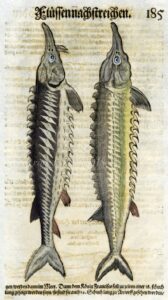 Hand-colored illustrations of sturgeons from Gesner, C. 1558. Historiæ animalium liber IIII, qui est de piscium et aquatilium animantium natura. Cvm iconibvs singvlorvm ad vivvm expressis fere omnib. DCCVI. C. Froschover, Tiburi [Zürich]. i-xx + 1-1297.
Hand-colored illustrations of sturgeons from Gesner, C. 1558. Historiæ animalium liber IIII, qui est de piscium et aquatilium animantium natura. Cvm iconibvs singvlorvm ad vivvm expressis fere omnib. DCCVI. C. Froschover, Tiburi [Zürich]. i-xx + 1-1297.
31 March
Acipenser Linnaeus 1758
Sometimes the more we know about a name, the less we know what it means. The sturgeon genus Acipenser is a case in point.
Acipenser is Latin for sturgeon (akkipḗsios in ancient Greek). That in and of itself is all we need to know. The Romans called that big fish with the bony scutes in the Adriatic Sea “Acipenser.” It’s the name Peter Artedi, the father of ichthyology, used in his unfinished catalog of fishes (he drowned in a canal). When Artedi’s friend and collaborator Carl Linnaeus incorporated Artedi’s work into the tenth edition of his Systema Naturae (1758), the official starting point of biological nomenclature, he retained Acipenser and thus became the “author” of a name that had been used for centuries.
It’s when we analyze the derivation of the word itself — acipenser — that things start to get hazy. Most contemporary “Fishes of …” books tell you that word is a combination of two Greek words: akis, meaning point, and pente, meaning five, referring to the five rows of bony scutes along a sturgeon’s body. The source of this explanation appears to be a paper from 1899: Kirsch, P. H. and M. W. Fordice. A review of the American species of sturgeons (Acipenseridae). Proceedings of the Academy of Natural Sciences of Philadelphia 41: 245-257. It’s the explanation we posted when The ETYFish Project went online in 2013.
Last year, a friend sent us a copy of the now-hard-to-find book A Glossary of Greek Fishes (1947) — currently $902.81 on Amazon — by the Scottish biologist, mathematician and classics scholar D’Arcy Wentworth Thompson (1860-1948). Prof. Thompson said the derivation of “acipenser” was unknown, but believed it to identical with “xipen-pennu,” the Egyptian name of the same fish. Unfortunately, the good professor did not elaborate.
If Acipenser is derived from an Egyptian name, then it would seem that sturgeons occur, or had historically occurred, in Egypt, off its Mediterranean coast. We searched the Internet for Egyptian records of Acipenser. We found none. We searched our hard drive. We found none there either. During our search, though, we found a short paper that we had downloaded in 2011 and forgotten about.
The paper is simply titled “Acipenser.” It was published in 2002 in Glotta, a journal of classical philology and linguistics. The author is Andrea Guasparri, a linguist-anthropologist who studies aquatic animals in Latin (ancient Rome) culture. Guasparri explains that the Latin names of many fishes are “almost entirely connected with recurrent images issued from the dry land.” In other words, fishes in ancient Rome were often named after the terrestrial objects they resembled. Acipenser is no exception. The name, he says, translates as acus, meaning needle, and pensum, meaning weight — but not weight as in kilograms or pounds. In this case, “weight” refers to a quantity of wool given to handmaids to be woven or spun daily. Pensum is also connected to pendeo, to hang down.
Semantically, according to Guasparri, Acipenser is a fish that “possesses a weight of needles,” inferring a connection between the needles used in weaving and the “needle-shaped barbels” that hang down from a sturgeon’s mouth.
We have no way of knowing if Guasparri’s etymological reconstruction is accurate. The widely accepted “five-point” explanation referring to the sturgeon’s sharp bony scutes seems more obvious to us, especially for anyone who’s handled a sturgeon without wearing gloves. But words often have surprising origins. What may have been an apt and obvious metaphor in ancient Rome (weaving needles) seems not-so-obvious, even far-fetched, today.
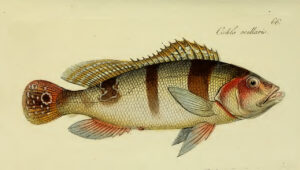
Cichla ocellaris. From: Bloch, M. E. and J. G. Schneider. 1801. M. E. Blochii, Systema Ichthyologiae Iconibus cx Ilustratum. Post obitum auctoris opus inchoatum absolvit, correxit, interpolavit Jo. Gottlob Schneider, Saxo. Berolini. Sumtibus Auctoris Impressum et Bibliopolio Sanderiano Commissum. i-lx + 1-584, Pls. 1-110.
24 March
An ETYFish editorial
Should Euro-centric binomials be revised to reinstate pre-existing indigenous names? The answer is “Yes” according to a proposal published last October in Communications Biology.
The authors “envisage taxonomic rule changes to promote retrospective name changes that establish, on the basis of precedence, pre-existing indigenous names for species where possible.” They decry what they call a “colonial” approach to nomenclature in which names were “habitually erected to honour collectors, sponsors, colleagues or employers who were often distanced from the country in question. In total this previous effort currently defines a large proportion of the nomenclatural diaspora.”
In addition, some of these “colonial” names may be deemed “insensitive to place and historical circumstance.” The authors call attention to the colloquial and pejorative name of “kaffir” in southern Africa that has been applied to a number of edible plant species. The word is incorporated into the name of a fish as well, the goby Caffrogobius caffer (Günther 1874). See the 4 April 2018 “Name of the Week” for our analysis of this name.
Such names, the authors continue, “convey no morphological nor ecological information. Instead, they merely recall outdated thinking that seems rather odd in a more pluralistic contemporary setting. These are names that are now likely to have little resonance for biologists in the country of origin and that may be, at best, irrelevant, and at worst, offensive, to the resident Indigenous Peoples.”
Instead, the authors, both from New Zealand, a country that has always — and honorably — afforded much respect and acknowledgment to their indigenous heritage, “envision a new order in which names such as the New Zealand forest tree species, Prumnopitys taxifolia would become Prumnopitys matai, the east African riparian tree species, Breonadia salicina (Vahl) Hepper & J. R. I. Wood would become Breonadia matumi, and the North American edible deciduous forest tree, Diospyros virginiana L. would become Diospyros pessamin. Such a legacy could become axiomatic under a new respect for indigenous precedence in nomenclature.”
What do you think? Here’s my “ETY-torial” opinion:
I’m all for naming new taxa after indigenous people, names, words, and cultural traditions. In fact, there is a growing trend of doing just that, especially among Neotropical fishes. Such names are fascinating and wonderful additions to the fish lexicon, with each one containing a nugget of history or cultural lure that I might never have otherwise learned. But I believe that changing long-standing Latin binomials to reflect indigenous knowledge will create a lot of unnecessary nomenclatural headaches.
For example, the authors suggest changing the name of the Neotropical cichlid genus Cichla — or one of its eight Amazon-basin species — to the vernacular name “tucunare.” But which one? Who decides? Does “Cichla Bloch & Schneider 1801” or “Cichla ocellaris Bloch & Schneider 1801” simply vanish from the historical and scientific record?
Renaming Cichla ocellaris to “Cichla tucunare” is not the same as renaming Mt. McKinley to Denali, or changing the name of the journal Copeia to Ichthyology & Herpetology. Biological nomenclature was invented by scientists for scientists, not for the public at large. And while those scientists were wholly if not exclusively European for at least a century — hence the Euro-centric bias of many of their names — that cannot and should not invalidate their contributions to a system predicated on stability.
There’s a practical side for not changing these names. Right now, you can go to the BHL website, enter “Cichla ocellaris,” and almost instantaneously gain access to 220+ years of literature pertaining to that taxon. That process gets needlessly more complicated — and long synonymies get even longer — if “Cichla ocellaris” is replaced with an indigenous name.
I wouldn’t be surprised if Cichla ocellaris or any of its congeners represents a complex of undescribed species. So, by all means, please bestow every single one with an indigenous name. Change common or vernacular names to reflect local culture. But unless a name can be considered offensive (such as the “caffer” example mentioned above), please leave the old scientific names alone.
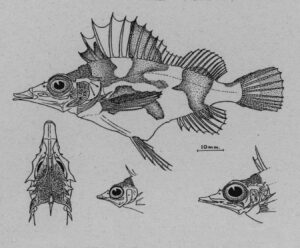
Alertichthys blacki. From: Moreland, J. M. 1960. A new genus and species of congiopodid fish from southern New Zealand. Records of the Dominion Museum (Wellington) v. 3 (3): 241-246.
17 March
Our 40,000th name: Alertichthys blacki Moreland 1960
Monday afternoon we recorded the 39,999th and 40,000th entries in the ETYFish Project database: the generic and specific names of the Alert Pigfish, Alertichthys blacki, a benthic scorpaenoid fish that occurs between 30 and 598 m in marine waters off southern New Zealand. It reaches 19.5 cm SL. Based on the structure of its pectoral-pelvic girdle, ichthyologists surmise that the fish “walks” on the seabed using its pectoral and pelvic fins, but this behavior has not yet been observed.
The fish represented both a new genus and a new species when it was described by Jack Munne Moreland (1921-2012), formerly of the Dominion (now Te Papa) Museum (Wellington, New Zealand), in 1960. Both halves of its name honor the boat and the captain of the boat from which the holotype was collected. The “Alert” of Alertichthys refers to the M/V Alert, an ex-Navy Harbour Defence Motor Launch. (Ichthys, of course, means fish.) The patronym blacki honors the Alert’s owner and captain, Alex J. Black, who made the vessel available to the Dominion Museum to investigate the bottom fauna in waters off the Otago Peninsula of Dunedin, New Zealand. Moreland specifically thanked Black for “many kindnesses extended” and for “expert advice and help in handling equipment.”
We started this ichthyo-etymological adventure in 2009, then believing it would take us until 2027 to complete our first pass. As of today, with approximately 1500 names left to research, we anticipate having 99.99% coverage of all Recent fish taxa later this year! (Covid-restricted library access and the names of sculpins and snailfishes described in obscure Russian publications may keep us from reaching a perfect 100%.)
But even after we’ve finished, we’re not finished. Over the course of researching 40,000 names, our understanding of Greek, Latin, and, especially, the etymological histories of pre-Linnaean names have improved. In addition, our “technique” has improved as well. Looking back on early entries (e.g., lampreys, shark and rays), we feel they are not as strong as later entries. So, when the last name is recorded later this year, we will go back to the beginning and essentially start over, revising, refining, sharpening, strengthening, and otherwise bringing more consistency to 2,500 pages of printed content.
We will do this, of course, while attempting to keep up with the 350 or so new fish species described each year, and a continuous stream of systematic and taxonomic changes — new classifications, new families, new genera, new name combinations, new (and resurrected) synonyms, new rules for name and publication availability, and so on. (Right now we have 60 recent papers in our “to do” folder awaiting their incorporation into the database.)
The adventure continues!
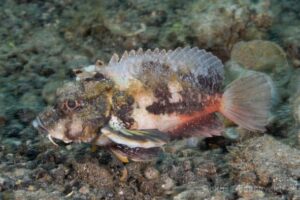
Minous groeneveldi. © Rokus Groeneveld. From www.diverosa.com
10 March
Minous groeneveldi Matsunuma & Motomura 2018
What if an ichthyologist named a fish after you and forgot to tell you? That’s what happened in the naming of this stingfish (family Synanceiidae) from Bali, Indonesia.
The description was published in the 2 August 2018 issue of the journal Zootaxa. According to the etymology section, “The name groeneveldi is proposed in honor of Mr Rokus Groeneveld, who provided us with excellent underwater photographs of the new species.” It was from Groeneveld’s photographs (one of which is reproduced here), that the authors, working from a single preserved specimen, were able to describe its colors in life.
Groeneveld learned that the fish was named after him a week after the description appeared. He found out when Bo Boelens, the senior author of the upcoming Eponym Dictionary of Fishes, wrote to him seeking additional biographical information about Groeneveld for the book.
“I must admit your request comes as a complete surprise,” Groeneveld replied.
Rokus Wessel Groeneveld (b. 1966) is a Dutch technical project manager for the Municipality of Gouda who dives for fun and pursues underwater photography as a hobby. He posts his photographs online (www.diverosa.com), which is where ichthyologist Mizuki Matsunuma saw Groeneveld’s photos of the then-undescribed stingfish. Matsunuma asked to use the photos, to which Groeneveld happily agreed.
“But I had no idea that it might indeed be a new species,” Groeneveld told Boelens. “And he named it after me! That’s really a huge honour for a hobby underwater photographer like me!”
Matsunuma & Motomura 2018 proposed “Groeneveld’s Stingfish” as the English common name for the species. We prefer the name Rokus Groeneveld uses on his website: Rokus Stingfish ;-).
The “;-)” is Groeneveld’s addition, not ours. 😉
A few words about the generic name Minous. Proposed by Georges Cuvier in 1829, the name is not Latin. Instead, it’s a latinization of minoo, from woorah minoo, the local name for Minous woora (=monodactylus) at Vizagapatam on the Coromandel Coast of India, as reported by surgeon-herpetologist Patrick Russell (1726-1805), who illustrated and described (but did not name) this species in 1803.

Teruya (Ted) Uyeno in 1966, from a slide in the collection of Carl L. Hubbs. Source: UC San Diego, Special Collections & Archives, Scripps Institution of Oceanography Collection.
3 March
Arigato, Dr. Uyeno
This week we mourn the loss of Teruya (Ted) Uyeno, who died 23 February, 2021, at the age of 90. He was Curator Emeritus at the National Museum of Science and Nature in Tokyo, Japan.
Dr. Uyeno received his Ph.D. at the University of Michigan, where he served as a post-doctoral fellow under Robert Rush Miller (see NOTW, 22 April 2016). During his “American” years, he collaborated with Miller on the description of the Allodontichthys hubbsi, a goodeid from southwestern México. The species is named in honor of ichthyologist Carl L. Hubbs (1894-1979), “whose early studies on goodeids set the stage for subsequent understanding of this compact but highly diversified family.”
After returning to Japan, Uyeno collaborated with Eiichi Fujii to propose a new genus and species of deepwater boxfish (family Aracanidae), Polyplacapros tyleri, from off eastern Australia and the Norfolk Ridge between New Zealand and New Caledonia. The generic name is a combination of “poly” (many) and “plac” (plate), referring to its body almost completely covered by plates, plus “capros,” wild boar, referring to the boar-like appearance of its head. The specific epithet honors American ichthyologist James C. Tyler (b. 1935), for his contributions to the study of tetraodontiform fishes.
Dr. Uyeno’s true passion was for fossil fishes. In the 1960s, he authored or co-authored a number of seminal papers on the Late Pleistocene fishes of North America. In his later years, his research focused on Miocene fishes of Japan, proposing several new taxa.
As far as we know, a fish has not yet been named in Dr. Uyeno’s honor. However, one fish name was inspired, in part, by him. In 1994, Russian ichthyologist Nikolai Vasil’evich Parin described the cutlassfish (family Trichiuridae) Aphanopus arigato, which occurs in the western North Pacific from Japan to North America, south to the Hawaiian Islands. Parin named it “arigato,” the Japanese word for “thank you,” as an expression of gratitude to several Japanese ichthyologists for hospitality and assistance during his visit to Japanese scientific institutions in October-December 1992. Dr. Uyeno was included in the thanks.
Over the past week on social media, many people who worked with or studied under Dr. Uyeno — in America and in Japan — have been saying “arigato” as well.
24 February
The widows of Antarctica

Oriana Souper Wilson in 1910.
Oriana Souper married physician-naturalist Edward Wilson three weeks before he set sail for Antarctica aboard the whaler and polar-expedition ship Terra Nova on 15 June 1910. Kathleen Scott said goodbye to her husband, expedition leader Robert Falcon Scott, a few weeks later. (Scott, detained with fundraising, took an ocean liner and caught up with the Terra Nova in South Africa.)
Neither wife would never see her husband again.
The Terra Nova expedition was Scott’s and Wilson’s second voyage to Antarctica. They had explored the “last place on Earth” from 1902 to 1904, adding much to the knowledge of the continent’s biology, geology, meteorology, and magnetism. This time, however, Scott had a bigger objective. He wanted to be the first person to reach the geographic South Pole.
When Scott, Wilson and three colleagues reached the Pole on 17 January 1912, they did not celebrate their achievement. The day before they had spotted a black flag belonging to a Norwegian team led by Roald Amundsen, who had beaten them to the Pole by 34 days. A crestfallen Scott wrote in his journal: “The Pole. Yes, but under very different circumstances from those expected … Great God! This is an awful place and terrible enough for us to have laboured to it without the reward of priority. Well, it is something to have got here.”
The party of five never made it back to the Terra Nova. Edgar Evans, a Welsh naval seaman, collapsed, fell into a coma and died due to frostbite and a probable concussion. Capt. Lawrence Oates, crippled with frostbite and gangrene, simply left his tent and walked into a −40°C blizzard, an apparent act of self-sacrifice. Thirteen days later, Scott, Wilson, and Henry Robertson Bowers, added to the party at the last minute for reasons still unclear, perished together inside their tent, trapped by a brutal, unrelenting blizzard that made walking impossible. A search party found their frozen bodies nearly eight months later. Wilson and Bowers were in their sleeping bags on either side of Scott. Scott’s arm lay across Wilson, his closest friend.
The Terra Nova returned to England with over 2,100 plants, animals and fossils, over 400 of which were new to science. Charles Tate Regan (1878-1943) of the Natural History Museum (London) studied the fishes and described 25 new species in 1914, all but four of which remain valid today.
Regan named two of the fishes in memory of Scott and Wilson: the Saddleback Plunderfish Pogonophryne scotti, and the Spiny Icefish Chaenodraco wilsoni. He could have named some of the other new fish species after Evans,* Oates and Bowers, but did not. Instead, Regan, chose to honor Scott and Wilson’s wives, now widows:
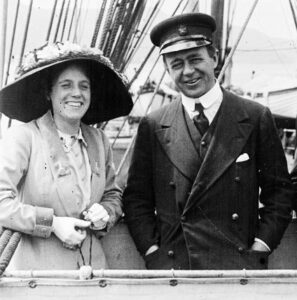
Kathleen Scott with Robert Falcon Scott in 1910.
Chionodraco kathleenae, a crocodile icefish, honors Kathleen Scott (1878-1947). She married Robert Falcon Scott in 1908. Their only child together was Peter Scott (1909-1989), the painter, broadcaster and ornithologist who helped found the World Wide Fund for Nature (WWF) and designed its panda logo.
Artedidraco orianae, a barbled plunderfish, honors Oriana Fanny Wilson (née Souper, ca. 1874-1945), who, as mentioned above, married Edward Wilson just three weeks before he set sail for Antarctica. Oriana later achieved fame for her humanitarian work during WW1. She was also a naturalist. In addition to the plunderfish, she has a bat and a cestode worm named in her honor. (Quite an interesting trio of animals!)
* Regan also described Prionodraco evansii, an Antarctic dragonfish, but he did not name it after Edgar Evans. Instead, the name honors the Captain of the Terra Nova, Edward Ratcliffe Garth Russell Evans (1880-1957). The 1993 book History and Atlas of the Fishes of the Antarctic Ocean, by Richard Gordon Miller, is incorrect in stating that P. evansii is named for Hugh Blackwell Evans, the “surviving Expedition Biologist” of Southern Cross Expedition to Antarctica, 1898-1900.
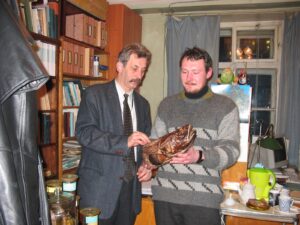
Arkadii Balushkin (left) in his office at ZIN examining Megacataetyx niki with Artem Prokofiev, in 2002. Courtesy: A. Prokofiev.
17 February
In memoriam: Arkadii Balushkin and Sergei Evseenko
A few days after we posted last week’s entry about a “silver lining” of the COVID quarantine, we were starkly reminded why we are quarantining in the first place. That’s when we learned that Russian ichthyologist Arkadii Vladimirovich Balushkin had succumbed to the virus on 11 February. He and his wife were both in the hospital with Covid symptoms. She survived. He did not.
Born in 1948, Balushkin received his Ph.D. in Biology at the University of Leningrad in 1979 and a D.Sc. at St. Petersburg University in 1997. He quickly established himself as the world’s leading expert on Antarctic fishes, particularly the icefishes of the suborder Notothenioidei, while serving as head of the Ichthyology Lab at the Zoological Institute (ZIN) in Saint-Petersburg. All told, he described 47 fish species new to science and 17 new genera. He also described a number of new unusual organs among Antarctic fishes, including supra-axillary swellings (convexitas superaxillaris), which produce and store the “antifreeze” that icefishes use to survive in sub-zero marine waters. His list of academic writings comprises about 150 publications. In July 2020, Balushkin received the L. S. Berg Gold Medal from the Russian Academy of Sciences for his work on the morphology, taxonomy and historical biogeography of the Antarctic fishes. The medal is named after Lev S. Berg, a Soviet ichthyologist and geographer.
In addition to naming many new fish taxa, several are named after him:
- a Whipnose Angler, Gigantactis balushkiniKharin 1984
- a Naked-head Toothfish, Gvozdarus balushkiniVoskoboinikova & Kellermann 1993
- the Palemouth Snailfish Psednos balushkiniStein, Chernova & Andriashev 2001
- a Dreamer anglerfish, Phyllorhinichthys balushkiniPietsch 2004
- a Ridgehead subspecies, Scopeloberyx malayanus balushkiniKotlyar 2004
- an Antarctic SculpinBathylutichthys balushkini, Voskoboinikova 2014
- a Gargoyle Fish Coelorinchus balushkini Schwarzhans, Mörs, Engelbrecht, Reguero & Kriwet 2016

Sergei Evseenko, courtesy P. P. Shirshov Institute of Oceanology.
Balushkin is the first ichthyologist we know of to die from Covid-19. Word has circulated that Balushkin’s colleague Sergei Afanasievich Evseenko also fell to the virus in October of last year, but our understanding is that while he died in the hospital surrounded by Covid patients, he had suffered a fatal heart attack or stroke. Born in 1949, Evseenko was Chief of the Laboratory of Oceanic Ichthyofauna at the P. P. Shirshov Institute of Oceanology, Russian Academy of Sciences. Like Balushkin, he specialized in Antarctic fishes, but studied Arctic fishes as well, especially flounders. He published over 160 scientific papers and, with Nikolai Parin and Ekaterina Vasil’eva, published a major work, Fishes of Russian Seas: Annotated Catalogue, in 2013.
The name of one fish species links these two ichthyologists. Muraenolepis evseenkoi, an eel cod from the Southern Ocean, was named in 2010 for Evseenko’s contributions to the study of Antarctic fishes. Arkadii Balushkin was the senior author of the description.
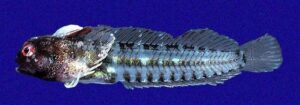
Coralliozetus clausus, freshly caught male from 1990. Photo by D. Ross Robertson. From: Hastings, P. A. 2021. The Pandemic Blenny, Coralliozetus clausus, a new species of tube blenny endemic to Isla del Coco, Costa Rica (Teleostei: Chaenopsidae). Zootaxa 4926 (2): 296–300.
10 February
The Pandemic Blenny, Coralliozetus clausus
One silver lining of the Covid-19 quarantine is that it has given some people the time to hunker down and do things they previously didn’t have the time or opportunity to accomplish. Take up painting, for example. Bake bread. Learn a foreign language. And in this case, describe a new species.
Coralliozetus clausus is a new species of tube blenny (Chaenopsidae) from Isla del Coco, a southeastern Pacific Ocean island approximately 550 km southwest of the Costa Rican mainland. It’s the 12th cryptobenthic (living on the seafloor, well camouflaged or hiding in crevices) fish species endemic to the island.
Philip A. Hastings, Curator of the Marine Vertebrate Collection at the Scripps Institute of Oceanography, penned the recently published (5 Feb.) description. When the Scripps campus closed in March 2020 due to the pandemic, Hastings grabbed specimens from the Scripps collection, as well as others on loan from other museums. Now that he was working from home without the distraction of curatorial duties, he resumed his “backburner research” on this new species, first collected in 1990.
He named the blenny “clausus” from the Latin meaning “enclosed” or “having been shut off,” referring to its restricted distribution on the island. (The generic name Coralliozetus, coined by Evermann & Marsh in 1899, is a combination of corallium, coral, and zetus, to seek, referring to the reef habitat of C. cardonae, a Caribbean species.)
Hastings’ selection of the “clausus” adjective has a personal meaning as well. “The name also refers,” he writes, “to the isolation imposed on the author by the Covid-19 pandemic, providing an opportunity to complete the description of this species whose distinctiveness had been known for some time.”
Hastings suggests the common name of Pandemic Blenny — Tubícola Pandémica in Spanish — “in light of these difficult times.”
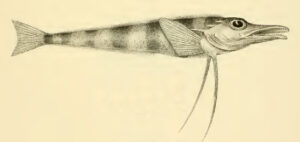
Pagetodes. From: Richardson, J. 1844-48. Ichthyology of the voyage of H. M. S. Erebus & Terror, under the command of Captain Sir James Clark Ross, R. N., F. R. S. In: J. Richardson & J. E. Gray (eds.): The zoology of the voyage of H. M. S. Erebus & Terror, under the command of Captain Sir J. C. Ross, R. N., F. R. S., during the years 1839 to 1843. E. W. Janson, London. v. 2 (2): i-viii + 1-139, Pls. 1-60 [pages 1-16 published in 1844].
Pagetodes Richardson 1844
I laughed when reading the original description of this genus. Of the 39,300-plus such descriptions I’ve consulted thus far, it’s the only one to elicit such a rib-tickling response.
Pagetodes is a genus of icefishes (family Channichthyidae) found in the Southern Ocean around Antarctica. Channichthyids (otherwise known as Crocodile Icefishes for the crocodilian shape of their heads and snouts) are noteworthy for being the only vertebrates that lack hemoglobin in their blood (as adults). Their blood is colorless. Living in water as cold as -1.8°C (seawater freezes at -2.0°C), it does seem they have ice water in their veins.
The genus was named and described by Scottish surgeon-naturalist John Richardson (1787-1865). It was Richardson’s job to describe the fishes collected by two retrofitted British warships, H. M. S Erebus and Terror, that explored the South Polar Seas and Antarctica during a four-year voyage starting in 1839. In the case of Pagetodes, however, Richardson lacked a specimen. Instead, he proposed the genus based on a sketch. The first paragraph of his account explained why, which caused me to chortle:
When the ships were in the high latitude of 77° 10′ S., and long. 178½˚, a fish was thrown up by the spray in a gale of wind, against the bows of the Terror, and frozen there. It was carefully removed, for the purpose of preservation, and a rough sketch was made of it by the surgeon, John Robertson, Esq., but before it could be put into spirits, a cat carried it away from his cabin, and ate it.
Robertson’s sketch, redrawn on stone (lithograph) by W. Mitchell, is shown here
The name “Pagetodes” means frozen or icebound. It’s not clear whether the name refers to the icebound wilderness where the fish was captured, or to the fact that it was found frozen on the bow of the Terror. Perhaps both.
Nomenclatural footnote: Pagetodes was only recently (2019) recognized as a valid genus. Since Richardson proposed it without assigning a species to it, the name was considered unusable, even though most icefish taxonomists were certain that Cryodraco antarcticus Dollo 1900 was Richardson’s fish. The matter was settled by Russian ichthyologist Boris A. Sheiko when he demonstrated that Richardson’s Pagetodes satisfied all necessary requirements of availability under the International Code of Zoological Nomenclature and thus, according to the Principle of Priority, must stand as the valid senior synonym of Cryodraco Dollo 1900.
27 January
Hopliancistrus wolverine de Oliveira, Zuanon, Py-Daniel, Birindelli & Sousa 2021
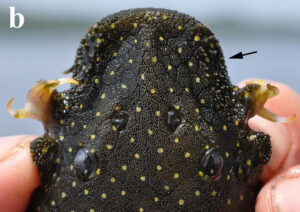
Dorsal view of head of Hopliancistrus wolverine, showing the odontodes on cheek plates and stiff odontodes on antero-lateral border of snout (black arrow). Photo by Mark Henry Sabaj. From: de Oliveira R. R., J. Zuanon J., L. H. R. Py-Daniel, J. L. O. Birindelli, and L. M. Sousa. 2021. Taxonomic revision of Hopliancistrus Isbrücker & Nijssen, 1989 (Siluriformes, Loricariidae) with redescription of Hopliancistrus tricornis and description of four new species. PLoS ONE 16(1): e0244894: 1-51.
When we first saw the name of this newly described loricariid catfish, we were certain it was named for the Marvel Comics character Wolverine. After all, fishes named after comic-book heroes and other franchise-driven pop-culture characters have become a minor trend over the years. There’s Cirrhilabrus wakanda (inspired by Black Panther), Otocinclus batmani, and two fishes named for characters from Star Wars, Romanogobio skywalkeri and Peckoltia greedoi, all featured in previous Names of the Week. What’s more, Hopliancistrus possess three claw-like and evertible odontodes — an odontode being a tooth outside of the mouth — on the cheek plates, and short, stiff odontodes on the lateral border of the snout. Clearly the name is a nod to Wolverine’s claws on each hand.
But we were only half right.
According to the authors, Hopliancistrus wolverine is named not for the Marvel character, but for the animal that inspired Wolverine’s name: “The specific name is an allusion to the Mustelidae Gulo gulo, also known as wolverine, glutton, carcajou, skunk bear, or quickhatch because of it’s [sic] blunt stature, strong claws, and ferocity.”
Although most loricariid catfishes have odontodes, those of the genus Hopliancistrus are the most robust. The authors state these catfishes use their odontodes as a “protective weapon, everting them deliberately to hold and stab the aggressor” — the “aggressor” in this case possibly being an aquarist or fish collector who handles a living specimen, unaware that inside its cheeks are dagger-like “claws” that literally shoot out and can slice human flesh.
The evertible odontodes make us wonder, though, if the inspiration for the name was indeed the Marvel character. After all, his claws are retractable. The claws on the wolverine are not.

Robert Kennicott, albumen silver print, ca. 1863. Photographer: Alexander Hesler.
20 January
Etheostoma kennicotti (Putnam 1863)
The Stripetail Darter occurs in small rivers and streams throughout the south-central United States of America. The body of the man for whom the fish is named is part of the human anatomy collection of the Smithsonian Institution.
Robert Kennicott (1835-1866) was a sickly kid who rarely went to school. Instead he stayed home on a large tract of land called “The Grove” in Glenview, Illinois. There he spent most of his time collecting plants and animals and patiently observing nature under the tutelage of his father, a naturalist himself. In 1852, his father’s friend, naturalist Jared Potter Kirtland, took on the young Kennicott as an understudy. Soon the young man was collecting specimens for the Smithsonian Institution in Washington, D.C., and, a few years later, penning the original descriptions of new snake species brought back by expeditions to the American West.
Between 1856 and 1858, Kennicott published a three-part paper entitled “The Quadrupeds of Illinois, Injurious and Beneficial to the Farmer.” In it, he pleaded with farmers to first study the habits of native prairie animals before attempting to eradicate them. This was a radical notion at the time. In 1856, he collected the darter that bears his name from a small brook in southern Illinois. In 1857, he and his colleague William Stimpson founded the Chicago Academy of Sciences.
In 1864, Kennicott became principal scientist of the Western Union Telegraph Expedition, mounted to find a route for a telegraph line between North America and Russia across the Bering Sea. He suffered ill health during the expedition. He died in May 1866 while traveling up the Yukon River in Alaska. It took a year for his body, sealed in a cast-iron coffin, to return home to “The Grove.”
In 2001, the naturalist who collected so many specimens became a specimen himself. With the permission of the modern-day Kennicott family, forensic anthropologists from the Smithsonian Institution exhumed his body to conduct an autopsy.
No one knew the exact cause of Kennicott’s death. Rumors had spread that he had committed suicide by swallowing strychnine. They concluded that Kennicott died of heart failure, the tragic culmination of an ongoing heart condition (diagnosed as QT Syndrome) that caused his poor health as a child. Kennicott exacerbated his condition with the strychnine he regularly self-administered to feel better.
Robert Kennicott’s body did not stay at “The Grove.” Again, with the permission of his family, his skeleton is now part of the Smithsonian’s human anatomy collection. Scientists scanned his skull and reconstructed his face using modeling clay. You can watch it here:
If Hollywood made a movie about Kennicott, the consensus around the Smithsonian’s physical anthropology department is that Johnny Depp should play the part.
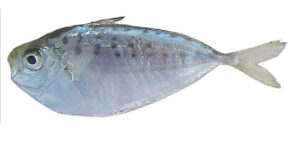
Deveximentum mekranense. From: Alavi-Yeganeh, M. S., M. Khajavi and S. Kimura. 2021. A new ponyfish, Deveximentum mekranensis [sic] (Teleostei: Leiognathidae), from the Gulf of Oman. Ichthyological Research Online First: 1-8.
Deveximentum mekranense Alavi-Yeganeh, Khajavi & Kimura 2021
According to Eschmeyer’s Catalog of Fishes, 354 new species of fish were described last year. Here is the first new species of 2021 — with an old, recurring mistake in the spelling of its name.
Deveximentum mekranense is a new species of ponyfish (Acanthuriformes: Leiognathidae) from the Gulf of Oman. The –ense suffix in the spelling of its specific epithet indicates that the name is a toponym, i.e., named for a geographic location. In this case, the name is derived from Mokran, an old Persian name for the Gulf of Oman. Some sources give the spelling as Makran, Mekran and Mecran. Such variances are not uncommon when Farsi is transcribed to a Latin alphabet, as indicated by the names of three other fishes:
- Omobranchus mekranensis (Regan 1905), a blenny
- Paraschistura makranensis Eagderi, Mousavi-Sabet & Freyhof 2019, a stone loach
- Plectorhinchus makranensis Damadi, Moghaddam, Ghassemzadeh & Ghanbarifardi 2020, a grunt or sweetlips
Why the authors of the Oman ponyfish use the “e” spelling in the name of the fish while indicating the “o” spelling in the etymology section is not explained.
But the spelling of Mecran/Mekran/Mokran/Macran is not the problem. The problem is with the “-ense” suffix. Unfortunately, the authors spelled the name mekrakensis, not mekrakense, an all-too-common mistake among taxonomists who do not realize that the –ensis/-ense suffix makes the name an adjective, in which case it must agree with the gender of the genus.
Usually, –ensis is correct. It works for both masculine and feminine genders. But the genus Deveximentum is neuter (devexum, hanging or declining down; mentum, chin, referring to oblique chin of D. insidiator). This explains the –um spelling (instead of –us) in the names of two congeners, D. indicum and D. interruptum. When the name of the genus is gender neutral, –ense is the correct spelling. This is a mistake we’ve seen and corrected many times.
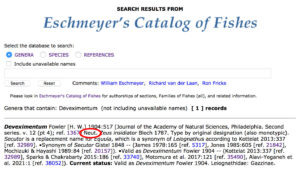 How do you tell if a fish’s generic name is masculine, feminine or neuter? Usually this involves looking up the name — or the final component of a compound name — in a Greek or Latin dictionary. But there’s a much easier way. Simply go to Eschmeyer’s Catalog of Fishes and enter the name in the genus field. The gender — Masc., Fem., or Neut. — is given after the hyperlinked reference number.
How do you tell if a fish’s generic name is masculine, feminine or neuter? Usually this involves looking up the name — or the final component of a compound name — in a Greek or Latin dictionary. But there’s a much easier way. Simply go to Eschmeyer’s Catalog of Fishes and enter the name in the genus field. The gender — Masc., Fem., or Neut. — is given after the hyperlinked reference number.
They’ve done the work for you!
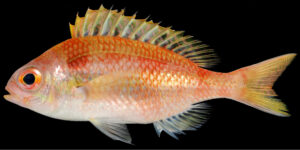
Parascolopsis akatamae. From: Miyamoto, K., C. D. McMahan and A. Kaneko. 2020. Parascolopsis akatamae, a new species of dwarf monocle bream (Perciformes: Nemipteridae) from the Indo-West Pacific, with redescription of closely related species P. eriomma. Zootaxa 4881 (no. 1): 91-103.
6 January
Parascolopsis akatamae Miyamoto, McMahan & Kaneko 2020
Something is amiss in the recent description of Parascolopsis akatamae, a new species of dwarf monocle bream (Nemipteridae) from the Indo-West Pacific. The explanation for the name akatamae in the etymology section does not match information given elsewhere in the description.
Quoting the authors, “The specific epithet ‘akatamae’ is derived from the local name in Japan of the type locality” (p. 96). The type locality is given as “off Motobu, Okinawa-jima Island, southern Japan.” In other words, “Akatamae” is the local Japanese name of either Motobu, a town on Okinawa island, or the island itself. The genitive “ae” suffix suggests that the name means “of Akatama.” A Google search for both “Akatama” and “Akatamae” revealed nothing of geographic relevance.
The etymology section also includes the standard Japanese name for the fish — Aka-tamagashira. Our guess is that “aka,” which means red in Japanese, may refer to the fish’s rosy coloration. “Tamagashira” is the Japanese word for members of the genus Parascolopsis.
It’s easy to see that akatamae is identical (minus the hyphen) to the first seven letters of Aka-tamagashira. The fish is said to be named for its type locality, yet the name echoes or appears to be related to the local name of the fish itself.
Seeking clarification, we sent an email to the description’s senior author, Kei Miyamoto, a Research Scientist at the Okinawa Churami Aquarium at Motobu, Okinawa. His reply:
“The scientific name is derived from its standard Japanese name ‘Aka-tamagashira.’‘Aka-tamagashira’ is used throughout Japan, including Okinawa-jima Island. Sorry for the confusion.”
We have a sneaking suspicion that the etymology sections of contemporary new-species descriptions are given only cursory attention by editors and peer reviewers. We see mistakes and oversights quite frequently. In this case, someone should have noticed that the phrase “derived from the local name in Japan of the type locality” should have read “derived from the local name in Japan of the fish.”